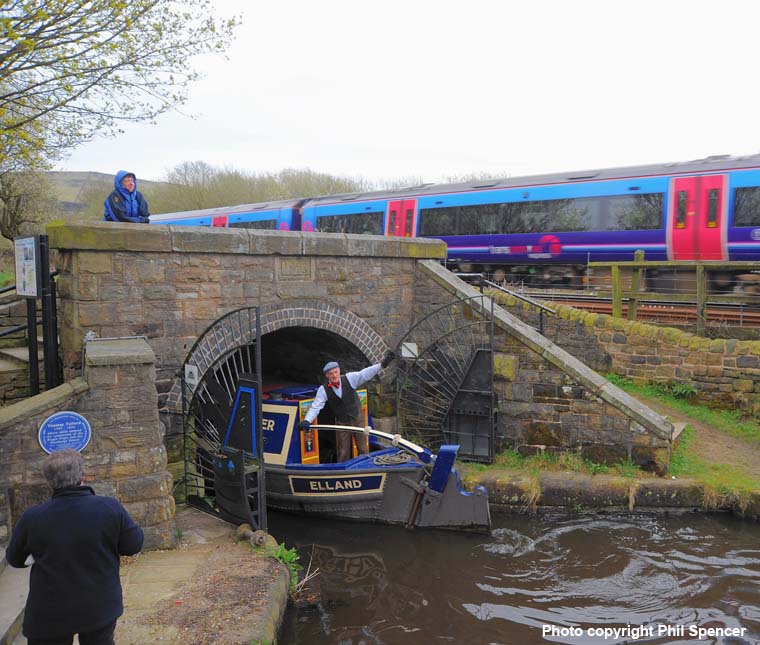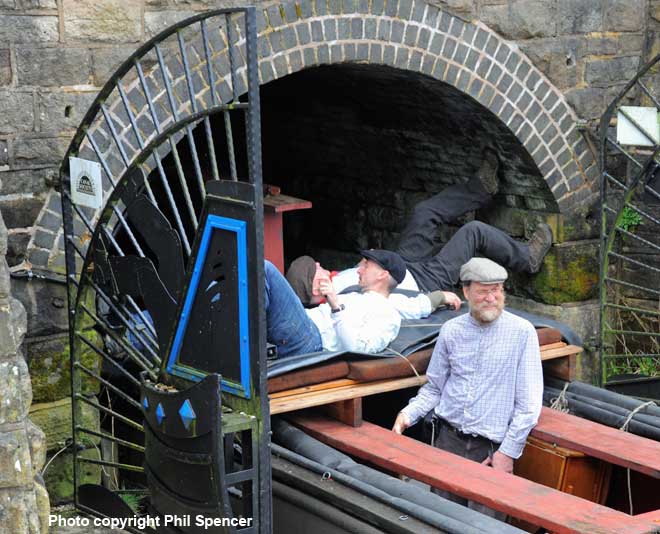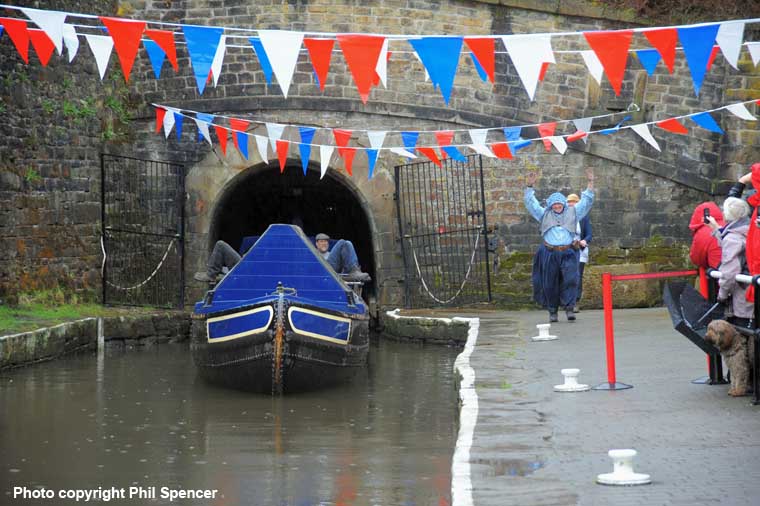PLEASE NOTE, DAVID IS CURRENTLY UNABLE TO UPLOAD IMAGES TO THIS PAGE DUE TO A GLITCH IN THE MR. SITE SYSTEM THEREFORE WITHOUT THE ACCOMPANYING MAPS AND PHOTOS THE PAGE REMAINS UNFINISHED. HE IS TRYING TO RESOLVE THE SITUATION AS SOON AS POSSIBLE AND I WILL KEEP YOU POSTED OF THE OUTCOME....DEREK DEAN
Now for the toughest challenge on the Great Way West since departing Paddington.
On leaving Newton Abbot, there is a one-mile stretch of level track as far as Aller Junction Signal Box, just before MP215¼, where 'the branch' to Torquay and Kingswear diverges from the main line, however our journey west to Plymouth is a much tougher task starting with a 3-mile climb of Dainton Bank, the steepest of the South Devon banks.
Immediately after Aller Junction there is a down loop where the 'rules' require all westbound loose-coupled goods trains of over 34 wagons to be assisted by a banker buffering-up to the rear.
Dainton Bank starts proper at Stoneycombe, near MP217 where a loop is provided on the down side in case of emergencies; our climb begins with a ruling gradient of 1 in 46 for the first 2½ miles followed by a stretch of 1 in 36 at its steepest on the final ½ mile to the summit just beyond the 291-yard Dainton tunnel.
Many books describe the challenge of the climb from Aller Junct to Dainton Summit; indeed it would be very unfortunate if an engine crew were to find themselves stopped on the climb. Even a mighty Class 8P 'King' was not allowed to attempt the climb unaided when hauling a train weighing more than 360 tons (consisting of ten or eleven bogies), therefore all down passenger trains of any length and weight took on a pilot loco at Newton Abbot, or earlier, while up trains took on a pilot at Plymouth North Road, or at Laira Junction as far as Newton Abbot.
The pilots were usually shown as AE (Assisting Engines) in lists and tabulations of locomotives used in reports where trains were noted along with the engines that hauled them.
After reaching the summit our train passes MP218 at Dainton Tunnel Signal Box (previously named Dainton Sidings) on the down side, behind which are refuge sidings used for storing crippled wagons requiring attention. The eagle-eyed might spot a large mirror used by the signalmen to check the progress of 'up' trains through the tunnel (the mirror is seen in the photo below) while the steepness of our descent to Totnes is clearly accentuated by the level siding on the up side used by banking engines awaiting a clear path back to Newton Abbot.
The next five miles into the Dart Valley near MP222¾ is equally precipitous as the climb from Aller Junction. Totnes station has platform loops and branch lines serving Ashburton in the north and Totnes Quay in the south. There is a small engine shed here for both branch locos and bankers which provided rear-end assistance for westbound trains now facing their second fearsome incline, the nine mile-long Rattery Bank.
Leaving Totnes, engine crews immediately face a rigorous 4¼ mile climb of between 1 in 45 and 1 in 70 before easing to 1 in 90 and then increasing to 1 in 65 to reach the summit at Wrangaton. During the climb we pass Tigley Signal Box near MP225½, followed by Rattery Signal Box near MP227¼, the 869 yard-long Marley Tunnel, and then just before MP229¾ we arrive at the junction station at Brent, where the 12½ mile branch from Kingsbridge joins the main line from the south.
After Brent there is another 2¼ miles uphill climb to the summit at Wrangaton almost at MP231¾, and our gruelling climb is over. From here there is a 7½ mile stretch through wonderful Devon countryside passing Bittaford Platform, Ivybridge and Cornwood, plus we cross five lofty masonry viaducts; Glaze, Bittaford, Ivybridge, Blatchford and Slade - all built in 1893 to replace Brunel's original timber spans mounted on slender stone piers.
On reaching Hemerdon Sidings Signal Box at MP239¼, there are passing loops marking the summit of Hemerdon Bank, and the line suddenly sweeps downhill at a falling gradient of 1 in 42 for the next three miles (torturous for engine crews on up trains) but our engine has a relatively easy downhill run down to Plympton, just before MP242, however high speed running is not permitted owing to the sharp curvature of the line.
After Plympton we pass through Tavistock Junction where the SR branch from Launceston sweeps in from the north, and we are very soon running alongside the River Plym estuary, past Ocean Siding and to Laira Junction Signal Box at MP244. Here the line crosses the defunct but still plainly visible 4 foot 6 inch gauge horse-worked Lee Moor (Plymouth & Dartmoor) Tramway.
On the left is Laira depot, 'The lair of Kings', with its large engine shed, coaling stage, goods yard and numerous sidings. The depot is home to about fifty 4-6-0s including ten 'Kings', plus a further 50 or 60 tender and tank engines.
During the final two miles from Laira Junction to Plymouth we pass Mannamead Signal Box between the site of stations at Lipson and Mutley, and then Mutley tunnel before arrival at Plymouth North Road at MP225¾.
(Below) Grange' class No 6841 Marlas Grange and Diesel Hydraulic A1A-A1A No D601 Ark Royal of Old Oak Common pass Dainton Tunnel Signal Box at the summit of the 5 mile climb from Totnes. This is the Up Cornish Riviera on Saturday 20 September 1958 during the first week of the Winter 1958 timetable. No 6841 was a St Philips Marsh (82B) engine, not commonly used as an assisting engine on this train, although a frequent visitor to Devon on holiday extras and freight trains. The aim of the D6xx 'Warship' class was to haul the main West Country expresses, but they proved unreliable and the WR soon relegated them to less prestigious duties.
The photo above provides us with a lot of interest, such as the large mirror above the first coach; the angle of the mirror enabled the signalman to confirm the continuity of up trains entering the tunnel by checking the presence of tail lamps which might otherwise be obscured by smoke and steam of a passing train, or by a stationary freight on the down main awaiting brakes to be be pinned down for the descent to Totnes. The photo also shows the wicked gradient profile as the down sidings and the single up siding were level while the main line dropped away very steeply towards Totnes. The sidings were used for storing cripple wagons and for bankers awaiting a path back to either Totnes or Aller.
On the 'BR Western Region - 2' page (P22) Andrew Fiderkiewicz has penned an interesting article called 'Dainton Memories' in which he writes - 'There was one significant working which we spotters would look out for and that was a relief for the down 'Riviera'. Normally the main train had a 'King' from Paddington and it would stop at Newton for a two 2-cylinder loco (either a Hall or Grange) to take the train on non-stop into Cornwall ('Kings' being banned from crossing the Royal Albert bridge). The 'King' would then await the arrival of the relief, which did stop at Plymouth and it would act as pilot to that train. Of course, that too could have a 'King' at the front and so we were sometimes given a show of strength as the train would leave Newton for Plymouth double-headed by two 'Kings'...happy days!'
(Below) The British Transport Commission's (BTC's) 1955 Modernisation Plan for British Railways led to the purchase a number of pilot-scheme diesel-electric and diesel-hydraulic locomotives. In 1958, the Western Region took delivery of the first of three 'lightweight' Type 4 B-B diesel-hydraulic 'Warship' class locomotives Nos D800-2, which were based on German engineering and built under licence at Swindon Works. This created a very useful power unit that led to the BTC ordering two additional batches of similar Swindon-built locomotives, along with a further order placed with the North British Locomotive Company (NBL). The WR's Type 4 'Warships' were divided into two classes: the BR Swindon-built locomotives D800-D832 and D866-D870, later designated Class 42 in BR's Total Operations Processing System (TOPS) while the remaining thirty three locomotives built by the North British Locomotive Company were numbered D833-D865, and became TOPS Class 43. The initial production cost of the first three locomotives (D800-2) was £143,000, but this was reduced to around £120,000 for each of the remainder. Nevertheless it was still a high figure compared to the manufacturing costs of the steam engines being built simultaneously in the same Workshops. The early days of the WR's Type 4 fleet were dogged by running defects, a situation only to be expected in view of the huge learning-curve required by crews and maintenance staff during the changeover from steam to more modern traction. However the fleet amassed high mileages in their formative years, showing good potential, although certain problems occurred; many related to the cooling groups due to a lack of maintenance and failure of thermostatic controls; this led to engines overheating, cracked cylinder heads and inevitable long periods out of service. Another major issue was their propensity for very rough riding at speeds above 80mph, this being attributed to the lack of lateral movement within the bogie design all of which required major rectification to eradicate the problem fully. The locomotives powered by Maybach engines were more reliable than those fitted with the MAN type, the latter being prone to exhaust manifold cracking and frequent engine failures due to malfunctioning big-end bearing locking-plates; again this resulted in majorly expensive crankshaft damage and time-consuming work to effect repairs. Here, the doyen of the 'Warship' fleet, No D800 Sir Brian Robertson, named after the then Chairman of the BTC, awaits departure from Newton Abbot with a midday Penzance to Manchester express in 1960.
(Above-Below) 00-0-a-rs-greenwood-GE2-9-7-61c Newton Abbott's original steam depot was replaced in 1893 by a new eight-road standard GWR pattern shed and allocated the code NA. The depot was designated the major shed for the region and included a heavy engineering repair shop for the maintainance and repair of all types of GWR locomotives. The last British Rail steam engine to be overhauled in the workshops was ex-GWR 4500 Class No 4566, which was outshopped on 15 July 1966. Adjacent to the workshop was a six-road carriage and wagon works, suitable for the maintenance and repair of all types of rolling stock. Cleaning was carried out on tracks between the station and the locomotive sheds. Rail Cameraman, RS Greenwood MBE, took this fine grandstand view of the shed yard showing no fewer than eight locomotives, though this being Sunday some engines are out of steam until the morning when they are stirred from their slumbers. 'Grange' class No 6859 Hewell Grange is positioned in the centre, parked in front of the mobile crane; while Mogul No 7316 moves forward with some coaching stock. Seeds of change are much in evidence with the diesel maintenance depot taking shape in the background. The depot had four roads with servicing pits and cab level platforms, providing facilities to repair eight locomotives at the same time. Also a daily servicing and fuelling point was built beside the old steam shed, while diesel multiple units were serviced in another open ended shed next to the carriage cleaning tracks. The diesel repair shed was closed in 1970, albeit the locomotive and coach servicing and fueling facility remained until 1981 when servicing was transferred to Laira Traction Maintenance Depot. (Below) 00-0-a-GE 5 GWR 7316 Newton Abbot Station 9 July 1961c copy. Splendid view of '4300' class 2-6-0 No 7316 awaiting departure from Newton Abbot's down relief platform with a semi-fast from Exeter on Sunday 9th July 1961. The Mogul was in its 40th year of service, firstly from Carmarthen in South Wales, then moving to (83C) Exeter in April 1946. Introduced in 1911 by George Jackson Churchward, these 'maids of all work' were equally at home on passenger or freight; as were the 'Grange' class locomotives which were built in 1936 under the direction of CME CB Collett using many parts from the withdrawn '4300' class engines. Photo R S Greenwood MBE Ref GE5.
(Above-Below) 00-0-a-rs-greenwood-6839-b A different view of Newton Abbot looking towards Forde Road on Sunday 9th July 1961; the photo encompassing so much of interest; outbuildings and railway infrastructure, wagons and signals, all serving to frame 'Grange' class No 6839 Hewell Grange which was allocated to (83B) Taunton depot at this time. Only a short spell was spent working from (83B) followed by a move to (84C) Banbury, but almost all of the engine's service was completed in the Wolverhampton Division at (84B) Oxley. This very useful class of eighty locomotives was derived using many parts from withdrawn '4300' class engines and negligible changes were perceived during their long careers. Photo RS Greenwood MBE.
(Above-Below) This is a fine shot of the rarely photographed train 666, the 3.35pm Friday Only Plymouth-Bristol Stapleton Road, sometimes extended to Cardiff; the ensemble is awaiting departure from Newton Abbot on Friday 27 May 1958. Train 665 used to be the number for the 12 noon from Penzance to Crewe, with carriages for Glasgow, but this was changed to 205 in 1953; its relief, 666, remained unchanged for the Plymouth-Bristol section of 130 miles. The 'Hall' class is No 4980 Wrottesley Hall of Bristol St Philip's Marsh shed, while the 0-6-0PT No 3606 in the bay platform is on a Teign Valley line train to Exeter.
(Below) WR10-271 46237 On Friday 20 May 1955, 'Princess Coronation' class Pacific No 46237 City of Bristol heads the up Cornish Riviera out of Newton Abbot en route to Paddington, with a dynamometer carriage behind the tender. The engine was on loan from the London Midland Region, to assist the Swindon Factory with regard to the benefits of double chimney and other draughting improvements, with a view to the findings being applied to the 'King' class of locomotives. The tests with this engine were successful and led to the whole class of 30 'Kings' acquiring double chimneys and other advancements, between December 1955 and April 1958. (Editor's note: the irony of the situation was not lost on the operating staff, for Sir William Stanier FRS was indeed trained at Swindon before making such an impact on the LMS). Photo CHS Owen.
(Above) WR10-272 7034 'Castle' class No 7034 Ince Castle heads towards Aller Junction from Newton Abbot with the down 'Cornishman'. The photo is undated, but the alloy headboard and lion and wheel emblem on the tender suggest 1955. No 7034 went to Bristol Bath Road from new in August 1950, and this remained its home shed throughout the Fifties. It acquired a Collett tender in June 1952 and stayed with the same design until withdrawal at the end of December 1963. I suspect this is the true Cornish portion of the down Cornishman, which did not call here, but on leaving Exeter St. David's at 2.05pm it passed non-stop through Newton Abbot at 2.30pm, due at its next stop, Plymouth North Road, 52 miles from Exeter, at 3.20pm. (Editor' note: the engine was modified with a double chimney in December 1959, but soon gained a bad reputation, just refusing to produce steam. Richard Woodley quotes in his excellent book entitled 'The Day of The Holiday Express' that on July 9 1960 the engine was replaced by the Reading station pilot on a Paddington to Kingswear service). Photo BKB Green, Initial Photographics.
(Below) WR10-275 6942 Seen leaving Newton Abbot is a Swindon Works excursion destined for Paignton and hauled by very recently overhauled member of the 'Hall' class No 6942 Eshton Hall of 81A Old Oak Common, dated Saturday 7 July 1962. The resplendent engine was enjoying its fifth year allocated to (81A), but had moved around four different MPD Divisions, varyingly from (84K) Chester to (83E) St. Blazey, spending more quota at Wolverhampton Oxley (OXY and 84B). REAL Photograph Ref R8135.
(Above) WR10-276 6967 5976 A busy scene is portrayed on Saturday 26 May 1951, as 'Modified Hall' No 6967 Willesley Hall of 84B Wolverhampton Oxley pilots Exeter shed's 'Hall' class No 5976 Ashwicke Hall at the head of the Penzance portion of the down 'Cornishman'. Meanwhile local 2-6-2 tank No 5150 waits to back down to couple onto the detached rear portion and head for Paignton and Kingswear, due there just before 4pm. The main train to Penzance will take somewhat longer, its scheduled arrival being 6pm. At this date, the portions were separated at Newton Abbot, as were the two up portions combined before these manoeuvres were performed at Exeter. Photo CHS Owen.
(Below) WR10-277 4708 On Maundy Thursday 29 March 1956, Churchward-designed 47XX class No 4708 of (81A) Old Oak Common hauls a relief train, numbered 145, otherwise spare, 11.40am ex Paddington-Plymouth, and has a clear signal to go forward at Aller Junction. These 2-8-0 locomotives were always held in high esteem by the railwaymen and by GWR enthusiasts, and though mainly used for fast fitted freights their power resources proved most useful on Summer Saturdays; helping out with many expresses to the west. Using 145 makes sense as 144 is the 11.30am to Penzance and 146 is the 12.00pm Torbay Express. I only make the point because gaps are not always left for extra trains to be logically inserted in numerical sequence. Between those two departures from Paddington was the 11.45am Hereford. (Editor's note: suprisingly No 4708 began its BR career working from (84B) Wolverhampton Oxley depot and did not move to (81A) until late 1952. Also of note is the small goods loop signal arm, tucked very neatly between the two main line signals). Photo CHS Owen.
(Above) WR10-279 46210 This remarkable photograph is dated Friday 10 February 1956 when all the 'King' class engines had been withdrawn, and the LM Region made four Pacifics available to help out; 'Princess Royal' class Nos 46207 & 46210 followed on from two* engines being loaned the previous week. Also eight** BR Standard Class 5MT locos came from the London Midland, and Southern Regions. Crewe North's 'Princess Royal' class 8P No 46210 Lady Patricia approaches Aller Junction with the down Cornish Riviera. The train number is being carried, but, unusually, and it is a pity in the circumstances, the titled train headboard is not on show, maybe due to the plate having only WR fitments. It seems the four loaned Pacific engines were much admired by the WR crews and that they performed very well. (*Editor's note: 'Princess Coronation' class Nos 46254 City of Stoke-on-Trent & 46257 City of Salford, both from 1B Camden were made available in addition to No 46210 & No 46207 Princess Arthur of Connaught, of 8A Liverpool Edge Hill depot. **Also LMR kindly allowed Nos 73001, 73010, 73045 to be used; while the SR sanctioned Nos 73085, 73088, 73110, 73114 & 73117, all brand new, to help the WR cause). Photo copyright CHS Owen.
(Below) WR10-280 5919 During its seven year stint at (82A) Bristol Bath Road, 'Hall' class No 5919 Worsley Hall moves on to the up line from Plymouth at Aller Junction, with the returning City of Bristol Holiday Express on Friday 10 August 1956, having brought people down to Paignton for a day out by the sea. On several weekdays in July and August, cities such as Birmingham, Bristol, Gloucester and Plymouth laid on day excursions to an attractive resort in the West Country, or such, and would usually utilise the same engine and crewmen for the duration of the week. Photo CHS Owen.
(Above) WR10-281 5055 On Saturday 2 July 1960, 'Castle' class No 5055 Earl of Eldon heads train A63, the 11.30am SO Torquay - Paddington, seen just after Aller Junction and before Newton Abbot where No 5055 is based. From new the 'Castle' was one of a large stud of express engines allocated to Old Oak Common (PDN), giving good service for over 21 years. Unfortunately, just over 2 years from the above date, the engine was resigned to storage and used sparingly for a further couple of years until condemnation. The fascinating book 'Operation Torbay' by WS Becket, Xpress publishing tells us that this train 'was intended as a non-stop relief to the Torbay Express which followed half an hour later and would almost certainly be full upon leaving Paignton. The stock of 11 vehicles first ran light from Newton Abbot to Torquay, running straight to the up platform so that the engine could run-round and set off without delay.' It is due at Paddington at 3.48pm.
(Below) WR10-282 6027 'King' class No 6027 King Richard I of (83D) Laira hauls the 8.30am Plymouth-Paddington 'Mayflower' on the up relief line between Aller Junction and Newton Abbot on 23 May 1958, the Friday of the Whitsun weekend. So far the train has eight carriages, but another five will be added at Newton Abbot from the 8.35am from Paignton that is due to arrive at Newton Abbot at 9.12am. After stops at Exeter, Taunton and Westbury, arrival time at Paddington is due to be 1.25pm. This King will be the sole haulage from Plymouth for the 5-hour run to the capital, unless at Reading, one of Laira's Halls is added as pilot, intended for hauling a down extra back to Plymouth later in the day on this bank holiday weekend. Photo CHS Owen.
(Above) WR10-283 6977 6397 On the approach to Aller Junction from Newton Abbot is train 435, the 7.43am SO Nottingham-Plymouth on Saturday 2 August 1958. The lead engine, 'Modified Hall' No 6977 Grundisburgh Hall of 82B St. Philips Marsh took this train over at Bristol Temple Meads from a London Midland loco and brought it to Newton Abbot. It then uncoupled to allow 43XX class Mogul No 6397 of 83E St. Blazey shed to be coupled to the train, with No 6977 repositioning itself as the front engine. I assume this was 'laid down in the rule book', even though it would take up several minutes on a busy Saturday. (Editor's note: the onus of responsibility was with the crew of the lead engine, as they would be watching for signals and operating the brakes as required, but maybe of more importance was the fact that the 'Hall' had the leading bogie which gave far more stability when dealing with a heavily loaded train). Photo is by WJ Probert.
(Below) WR10-284 7018 82A Bristol Bath Road's 'Castle' class No 7018 Drysllwyn Castle is being used by the WR for test purposes, is on its first day of trials with its recently fitted experimental, fabricated double chimney on its debut on the down 'Torbay Express' on Tuesday 24 July 1956. After reaching Kingswear, and using the turntable there, No 7018 is now used, with no change at the front of the engine, to bring the dynamometer car and the Goodrington Sands-Newton Abbot goods the nine miles back to Newton Abbot. Photo REAL Ref R8134.
(Above) WR10-285 92245 Constructed in November 1958, class 9F No 92245 of (81A) Old Oak Common heads a (so far) quite short 12.20pm Penzance-London milk tanks train as it approaches Newton Abbot on Saturday 30 July 1960. Even though there was much extra holiday traffic today, the running of milk trains needed to continue as usual. During its journey to the capital, the train will collect more tanks at Exeter, Tiverton Junction, Wellington, Taunton, Castle Cary, Frome and Westbury, and then it will proceed via Lavington and the Berks & Hants line, and the West Ealing Loop, probably after an engine change, to Wood Lane depot in North Kensington arriving soon after 1.30am. To the casual observer, these tanks were believed to be oil containers, such was their external condition in most instances. The V69 chalked on the front of No 92245 is a mystery to me; as far as I can tell, V69 was assigned to a Newcastle-Cardiff service. (Editor's note: this particular engine remained at WR depots; Cardiff Canton, Oxford and Southall in the main, but it became an early candidate for withdrawal after just 6 years in service). Photo CHS Owen.
(Below) WR10-286 75026 6018 A slightly strange-looking combination on the face of it, as a new BR Standard Class 4 No 75026 (allocated to 83D Laira in May 1954) pilots 26-year old 'King' class No 6018 King Henry VI of (81A) Old Oak Common at Aller Junction on Tuesday 13 July 1954. The train is the 12 noon ex-Penzance to Crewe West to North Mail consisting of a typical load of a TPO coach followed by six passenger carriages and a few vans. No 75026 will come off at Newton Abbot and the 'King' will continue on to Bristol. It appears that no cleaning of any description has been attempted to the BR engine, but Swindon have been busy with some refinements; the exhaust ejector has gained a control valve (see Britannia Pacifics page 90) and some added equipment there; also Automatic Train Control fitments are in place, in addition to raised sandbox lids, brought into the building programme at Swindon Works. Nos 75025 to 75029 inclusive were delivered new to (83D) Plymouth Laira, from Swindon Works during early 1954, in answer to a request by the Western Region for engines that could work over longer distances. Photo CHS Owen.
(Above) WR8-21 5997 48431 From 1948 the Western Region had 62 ex-LMS Stanier class '8F' 2-8-0's working throughout their system, of which exactly 50% were built at Swindon Works, who managed to construct 80 engines of the class (12%), from May 1943 until July 1945; these being numbered (4)8400 to (4)8479. The remainder came from other Locomotive Builders such as Vulcan; Crewe and Beyer Peacock. William Stanier-designed '8F' class No 48431 is a (82B) Bristol St. Philips Marsh loco, and is the train engine behind 'Hall' class No 5997 Sparkford Hall of 82C Swindon depot. The train is the 4.25pm Plymouth Millbay to Paddington parcels passing Aller Junction before Newton Abbot on Wednesday 17 June 1959. This train always produced an interesting pair of locos and a mixture of vans, siphons, full brakes etc., and a modeller's dream. (Editor's note: the history of the Stanier '8F' is complex, but briefly there were 852 constructed; 663 ran on BR lines; 182 remained abroad, while 7 were lost at sea in two shipping accidents). Photo, CHS Owen.
(Below) WR10-287 75026 5350 BR Standard class 4 No 75026, of 83D Laira, pilots Mogul class 4MT No 5350 of 82C Swindon shed on the 4.25pm Plymouth Millbay to Paddington perishables passing Aller Junction; 2 Cordon gas wagons lead the usual varied set of stock. No 75026 is about to be transferred to 82C Swindon to join its far older partner which dated from 1918 and remained in useful service for 41 years; a testament to George Jackson Churchward, its creator. Note a County Class loco is passing light engine on the down line before the Torquay branch. The date is Friday 18 May 1956, the day before the Whitsun weekend. Photo, CHS Owen.
(Above) WR10-289 7916 92206 (10.289) 'Modified Hall' class No 7916 Mobberley Hall of (83A) Newton Abbot and BR Standard Class 9F No 92206 of (82B) St. Philips Marsh look to have plenty in reserve at the head of the 4.25pm Plymouth Millbay to Paddington parcels on Wednesday 24 June 1959, as seen from the road bridge at Aller Junction. This powerful combination should be on schedule as it was a weekday working and No 92206 was barely one month old and probably quite able to manage the train independently. The uncertain nature of the loading meant that two locos were rostered for the duty, irrespective. The BR-built 'Hall' remained in the Newton Abbot Division from its first duties until June 1964; whereas the '9F' assumed nomadic proportions and saw service at Westbury (82D), Eastleigh (71A) for 2.5 years; York (50A) for more than 3 years, then ending its short career at Wakefield (56A). Photo, REAL photographs, Ref R8177.
(Below) WR10-290 75000 5058 BR class 4 No 75000 of 82C Swindon pilots 'Castle' class No 5058 Earl of Clancarty on train 649 the 1.20pm SO Penzance to Paddington express as they come past Aller Junction on Saturday 23 August 1958. No 5058 is now at Laira, having 2 weeks earlier been put back in traffic after a Heavy Intermediate overhaul at Swindon Works. The BR Standard will come off at Newton Abbot, one mile ahead, leaving the 'Castle' to continue without assistance. As this is during the peak holiday period, it may prove difficult to get to Paddington by the due arrival time of 9.05pm. Photo by REAL photos, Ref R8189.
(Above) WR10-291 6008 5196 The uncommon sight of a 'King' in front of a 2-6-2 tank engine, captured at Aller Junction. The up Cornish Riviera Limited is hauled by class No 6008 King James II of (83D) Laira depot plus Newton Abbot's '5101' class 2-6-2 tank engine No 5196, on Saturday 17 August 1957. The up Riviera doesn't call at Newton Abbot unless a pilot engine is to be taken off. Today the 2-6-2T emgine has to be removed from the train before departure for London. I understand the rule is that if a train is piloted from Plymouth or Laira by a tank engine or Mogul, the pilot would be 2nd loco, but if the pilot is a 4-6-0, then that would be the lead engine. But if the pilot is not added at Plymouth or Laira, but at Totnes, the tank engine or Mogul would lead. (Editor's note: my understanding of the situation is that a pilot engine having a pony truck bogie would not be allowed to take the lead; the risks were too great).
(Below) WR10-293 5153 34075 Adding to the loco variety, a SR engine hauled trains between Exeter and Plymouth four time a day. In this 1959 instance, '5100' class 2-6-2T No 5153 pilots SR Light Pacific No 34075 264 Squadron on the 5.30 SX Exeter St David's-Plymouth North Road stopper, seen here approaching Aller Junction. The purpose of these duties was to familiarize SR crews with the Western Region route, in case mishaps caused a blockage on the SR route. Two such trains ran each weekday in both directions on each route, making a total of eight such trains operating. As well as this train running, the other down train was the 11.25am SX from Exeter. The two up trains were departures from North Road at 2.15pm and 4.32pm. Photo REAL Ref R8182.
(Above) WR10-294 6009 6021 Contrary to appearances this is not the down 'Cornish Riviera', it is the 10.35am SO Paddington-Penzance (Train Reporting Number 133) which departed Paddington a few minutes after the Saturday Riviera, closely shadowing it throughout its journey with a scheduled 5.40pm arrival at Penzance just fifteen minutes behind the main train. What has happened here is that 'King' class No 6009 King Charles II had earlier brought the 10.30am Paddington-Penzance 'Cornish Riviera' into Newton Abbot where it handed over to a pair of 4-6-0s for the remainder of the journey to Cornwall. Meanwhile 'King' class No 6021 King Richard II arrived at Newton Abbot with the 10.35am SO Paddington-Penzance and No 6009 (still retaining the headboard and 130 reporting number) coupled up to the front and departed a few minutes after the actual 'Riviera'. This was standard Saturday practice during the summer timetable, although the majestic sight of a train double-headed by a pair of 'Kings' is unlikely to be seen again in 1955 as it is the last weekend of the summer timetable. Both locomotives at the time were part of the Old Oak Common's top-link stud. Photographer CFH Oldham captured the pair at the start of the climb to Dainton summit on Saturday 17 September 1955.
(Below) WR10-279A After a lengthy wait for a convenient path, Collett 2-8-2T '72XX' class No 7220 of (83A) Newton Abbot depot makes headway out of the down loop at Aller curve. The use of a banker engine was a regulation instruction for any goods train of more than 35 wagons, with the second locomotive buffering-up to the rear-end enabling it to drop away when the difficult climb to Dainton summit had been completed. These 2-8-2T engines were rebuilds of random Churchward 2-8-0T '42XX' class engines as overseen by Collett, to give far greater range of working area. Real Photographs, Ref T8421
(Above) WR5.17 This unusual combination was captured by CHS Owen at Aller Junction on Saturday 27 May 1961; it shows '5100' class 2-6-2T No 5153 has been switched from banking duties at Totnes to rescue 'Castle' class No 5014 Goodrich Castle of (81A) Old Oak Common, which has failed on the 'up' 'Mayflower' near Totnes. Having left Plymouth at 8.30am, but now running late by half an hour or more, not only has the 'Mayflower' lost its path at important points along the route, passengers aboard the 8.35am ex-Kingswear portion which connects with the 'Mayflower' at Newton Abbot are faced with a long delay after their 9.22am arrival. 'Our man at Totnes' will have telephoned ahead to forewarn control at Newton Abbot, and the operating department will be frantically locating a suitable replacement loco to cover this setback, only then will the train be able to continue to London, albeit its arrival at Paddington will be much later than its intended 1.40pm. These are just some of the operating decisions to be taken in such circumstances, in addition to which a replacement banker had to found at Totnes to provide assistance on Rattery Bank. Postscript: did passengers on the 8.35am ex-Kingswear - plus any other passengers planning to catch the 'Mayflower' at its scheduled stops at Exeter, Taunton and Westbury - have to await its late arrival, or perhaps a spare locomotive and coaching stock was provided at Newton, thus honouring the rail travellers' expectations of the timetable? Photo CHS Owen, REAL Ref R8100
(Below) WR10-291 The uncommon sight of a 'King' in front of a 2-6-2 tank engine is captured at Aller Junction on Saturday 17 August 1957. Here the up 'Cornish Riviera Limited' is hauled by No 6008 King James II of (83D) Laira depot plus Newton Abbot's '5101' class 2-6-2 tank engine No 5196. The up Riviera didn't call at Newton Abbot unless a pilot engine was to be taken off. Today the 2-6-2T will be removed from the train before departure for London. I understand the rule is that if a train is piloted from Plymouth or Laira by a tank engine or a Mogul, the pilot would be the 2nd loco, but if the pilot is a 4-6-0, then this would become the lead engine. But if the pilot is not added at Plymouth or Laira, but at Totnes, the tank engine or Mogul would lead. (Editor's note: my understanding of the situation is that a pilot engine with a pony truck bogie would not be allowed to take the lead; the risks were too great). Photo CHS Owen.
(Above) WR10-295 BR Class 7MT 'Britannia' Pacific No 70017 Arrow of (81A) Old Oak Common comes round Aller curve with a short westbound express from Paddington for Plymouth, a comfortable task for engine and crew. The Pacifics were considered 'alien' by some crews on the WR and generally disliked, but they did find favour with Cardiff Canton crews who put them to good use. This engine shows five visible differences from new; details can be gleaned on page 91. Photo REAL Ref R8212.
(Below) WR10-296 In the final month before its transfer to 82C Swindon shed, BR Standard Class 4 No 75026 of (83D) Laira pilots 'County' class No 1018 County of Leicester of 83G Penzance shed on Aller curve with a return Saltash excursion at the start of the Whitsun weekend on Friday 18 May 1956. With ten coaches this seems a well supported excursion, and I suspect the photographer will see a great deal more than the usual amount of traffic on this day. Photo CHS Owen.
(Above) WR4.42) Preparing to attack the 3-mile climb of Dainton bank, the steepest section being a fierce 1 in 36, 'King' class No 6015 King Richard III plus GWR '3700' class No 3440 City of Truro head the 5.30am Paddington - Penzance express on Thursday 12 September 1957. The 'King' came on at Bristol, while No 3440 came on at Didcot. 3440 was being worked to Plymouth for a Sunday excursion to Penzance. It is interesting that 6015 was assigned new in June 1928 to PDN, which was then Old Oak Common's abbreviated code until late 1948 when it was re-coded 81A. The 'King' had no other home shed for thirty four years until June 1962, when for the last three months of its life it was assigned to 84A Wolverhampton Stafford Road depot. Official documentation purporting to show it was allocated to Aylesbury in May 1947 was actually a typing error (the document should have read 6105). No 3440 went back to Swindon on Monday 16 September on the 3.55pm Plymouth - Swindon parcels led by 'Hall' class No 6902 Butler's Hall. Photo CHS Owen.
(Below) WR10-297 6806) On Thursday 31 July 1958, 'Grange' class No 6806 Blackwell Grange from faraway 84B Wolverhampton Oxley (assuming the date to be correct, because it would almost certainly revert to its 83G Penzance allocation), has been waiting patiently for a break in the westbound traffic to exit the loop at Aller curve, and proceed with a Class H goods train loaded with supplies of coke. At the rear, one of Newton Abbot's 2-6-2 tank engines provides rear end assistance to Dainton summit. It is rarely recognised that instructions stated that banking engines from Aller to Dainton were not to be coupled to the guard's van, but merely buffered-up thereby allowing them to 'drop away' at the summit without stopping the banked train. Photo RW Hinton.
(Above) WR10-298 1014 5183 Here's an interesting and rare sight…'County' class No 1014 County of Glamorgan of 82A Bristol Bath Road and '5101' class 2-6-2T No 5183, each in reverse, bring the empty coaching stock of an excursion towards Langford Bridge on Friday 13 June 1958. My assumption is that 1014 had brought a train load of passengers to Totnes, for a trip on the River Dart to Kingswear. This train will now travel empty to Newton Abbot and then work to Kingswear to collect the passengers following their river trip. No 1014 was a Bristol Bath Road shed from new in February 1946, and withdrawal came in April 1964 after a mileage of 756,762. Newton Abbot shed had about ten of the 2-6-2T engines, perhaps No 5183 was hitching a lift back after completing its branch and banking duties at Totnes? Photo GW Sharpe.
(Below) WR10-299 5920 5087 A combination of 'Hall' class No 5920 Wycliffe Hall of (83A) Newton Abbot and scruffy 'Castle' class No 5087 Tintern Abbey of (81A) Old Oak Common, are approaching Aller Junction from the Plymouth direction with a London bound express in 1951. Note the tender of No 5920 is still displaying Great Western livery; also one has to admire the well laid and ballasted track, which is heavily used both day and night. Photo A G Ellis 28751, ML Boakes Collection.
(Above) WR10-300 5982) Approaching from the Plymouth direction is Forces train 28F1, headed by 82B St Philips Marsh shed's 'Hall' class No 5982 Harrington Hall of on Tuesday 28 July 1953. I have never been able to interpret what the numbers of Forces trains mean, except the 28 here relates to the date of the train. The carriages look in very good condition, somewhat better than how some sets provided for such trains can look. It is something of a rarity to find an express without an assisting engine travelling over these Devon banks, but 5982 looks as if it is purring gently coming on the down gradient here of 1 in 57 then 1 in 98 before Langford Bridge and the approach to Aller Junction. Photo RE Toop Ref X82
WR10-301 (Below) 'Grange' class No 6825 Llanvair Grange of (83G) Penzance shed and 'Modified Hall' No 7928 Wolf Hall of (85A) Worcester, head the 11.05am SO Newquay-Wolverhampton past Stoneycombe Quarry on the descent of Dainton bank; at this point the downward gradient is 1 in 56 in their favour. The photo was taken on 23 August 1952. Built in February 1937, No 6825 spent all its working life based at West Country sheds until October 1962 when it moved to Reading depot. No 6825 was withdrawn from 82E Bristol (Barrow Road) in June 1964 with a mileage of 1,019,472. No 7928 was new in October 1950, and became a lifelong 85A Worcester-based engine until withdrawal in March 1965. The 11.05am SO Newquay-Wolverhampton was due at Newton Abbot at 2.20pm, where 6825 will come off and leave the 'Hall' to continue alone to Wolverhampton via Bristol, Cheltenham (Malvern Road) and Stratford-on-Avon. (Editor's note: of interest is the two different tenders in use; Hawksworth (7928) and Churchward (6825), not the more usual Collett type. Also No 7928 has a mechanical lubrication unit fitted, in keeping with ten other 'Modified Halls' all built under BR) Photo RJ Buckley.
(WR10-302Above) Fresh out of the box in May 1954, Newton Abbot's BR Standard Class 4MT 4-6-0 No 75028 heads the 9.15am SX Liverpool-Plymouth past Stoneycombe Quarry on the climb to Dainton summit. The gradient and curvature of the line can be well realised from this position. I'm surprised there is no pilot engine, unless the operating department was seeing 'what the new BR 4-6-0 can do'! This REAL photo Ref R8221 dates from late 1954.
(10.303Below)Two very versatile GWR 4-6-0 engines working hard are 'Hall' class No 5920 Wycliffe Hall of (83A) Newton Abbot shed which is piloting 'Grange' class No 6845 Paviland Grange of (83G) Penzance on the down 'Cornish Riviera' past Stoneycombe Quarry halfway up Dainton bank. Following a failure of the 'King' that brought the train to Newton Abbot the service was running over one hour late. The date is Saturday 21 April 1956; the information and photo are by CHS Owen
(WR10-304Above) When the 'King' class locomotives were withdrawn for urgent repairs to the leading bogie between late January and late February 1956, four Class 8P Pacifics were loaned from the London Midland Region. One of them was 'Princess Coronation' class No 46254 City of Stoke on Trent of 1B Camden depot, seen here being piloted by 'Manor' class No 7809 Childrey Manor of (83D) Laira at the head of the down 'Cornish Riviera' past Stoneycombe Quarry on Sunday 5 February 1956. Photo CHS Owen.
WR10-305 (Below) BR-built 'Castle' class No 7025 Sudeley Castle of (85A) Worcester shed storms Dainton Bank past Stoneycombe Quarry with the famed Ian Allan Rail Tour of Saturday 9 May 1964. No 7025 had taken over at Taunton from 'Modified Hall' 6999 Capel Dewi Hall, which had stepped into the breach to replace the failed 'Castle' class No 4079 Pendennis Castle on arrival at Westbury from Paddington. Neither of the two heroes of the day, Nos 7025 and 6999, survived being scrapped whereas 'Pendennis Castle' has been carefully preserved after clocking up 1,800,000 miles when in GWR & WR service. Photographer is unknown.
WR(10.307 Above) From Atlantic Transport's excellent 'Summer Saturdays in the West' by David St John Thomas and Simon Rocksburgh-Smith is the following information - 'It is Saturday 27 July 1957, and 'Britannia' class No 70024 Vulcan of (86C) Cardiff Canton and 'King' class No 6018 King Henry VI of (81A) Old Oak Common are on the 9.30am Paddington-Newquay, toiling up Dainton bank with 13 coaches. 6018 had brought the train from Paddington, 70024 had brought train 430, the 6.35am Walsall-Kingswear from Bristol to Newton Abbot, arriving there at 3.18pm 147 minutes late. It was then coupled ahead of 6018 which had turned up at 3.46pm 150 minutes late. The operation took 20 minutes, so the train left Newton at 4.06pm 166 minutes late. The train reached Plymouth North Road at 5.10pm 173 minutes late; both came off and 'Modified Hall' class No 7909 Heveningham Hall of (83D) Laira and ' Hall' class No 4906 Bradfield Hall of (83E) St. Blazey came on to take the train further. Instead of reaching Newquay for 5.30pm I expect it arrived three or so hours late…' Photo Ben Brooksbank, Initial Photographics.
WR10-308A (Below) Just seventy six WD 'Austerity' 2-8-0s were used by the Western Region, but they had a vital use, hauling long, heavy coal trains, during the day and night. Here is a daytime shot of No 90284 of 82B St. Philips Marsh, toiling up Dainton bank with a banker at the rear on Sunday 24 April 1955. This particular workhorse was completed in December 1943 for the war effort and allotted No 7408 before being sent to France. On its return to Britain, a new number was arrived at by adding 70,000, seen from 1945, before BR assigned No 90284 from 1952. Allocations were briefly at Oxley, Banbury, Worcester and Southall before arriving at St Philips Marsh in October 1953; it later saw service at Oxford, before leaving the WR in July 1959. REAL photos, Ref R8225.
WR10-308B (Above) Seen hauling the down 'Cornish Riviera' with eleven on, are Laira's '3300' class 4-4-0 Bulldog No 3431, never named, which is piloting 'King' class No 6027 King Richard I, just relocated from Old Oak Common to Newton Abbot. The pair are soon to enter Dainton tunnel after the three mile climb from Aller Junction. This photo is probably just post WW2 and 3431 is in a class designed by William Dean in 1898. Ben Brooksbank tells me it was built in August 1906, initially numbered 3721, gaining its new number in December 1912. It was withdrawn in December 1948 and credited with a final mileage of 1,181,357. Photo FJ Arthur.
WR4-17 (Below) A powerful study of Churchward 2-8-0 No 4807, now an oil-burner of 83D Laira shed, storming up the final stretch of Dainton bank in 1947. No 4807 reverted back to coal-firing in July 1949 and was allotted its original number of 2848 (1912-1959). The longer term intention was to have as many locos as possible working west of Taunton to be oil-burners, thus saving the expense of hauling so much coal from South Wales to the West Country. But despite spending so much money on relative equipment and storage tanks, not to mention the numerous locomotives which had undergone conversion and therefore needed rectification, the oil-burning scheme had to be abandoned in May 1948 when the country ran out of money to buy the oil on world markets. This is a wonderful photograph from the J Scott-Morgan collection, distributed by RS Carpenter.
WR10.309 (Above) 'King' class No 6008 King James II takes the 10 coaches of the down 'Cornish Riviera Express' on Friday 12 August 1955; the loco is about to enter Dainton tunnel, with a lot of steam escaping from inside cylinders, despite blowing off fiercely. No 6008's home shed had been (83D) Laira since June 1952, and would remain so until February 1959 when the management decreed that it move to (84A) Wolverhampton Stafford Road. Built in March 1928, little had changed on the engine until a 'WB' boiler was fitted in December 1955; then a double chimney was fitted in July 1957, changing the engine's performance and ability to steam. No 6008 was withdrawn in June 1962 after clocking up 1,695,925 miles. Of particular note is the very flat roof of each of the first five carriages, these being Hawksworth designed stock, first seen in 1948. Photo RE Toop Ref C76.
WR10-310 (Below-Inset) 'Hall' class No 6958 Oxburgh Hall of Bristol Bath Road (BRD) is captured at the head of train 806, a South Wales-West Country SO express in the Summer of 1948; the engine appears to have climbed Dainton bank without too much trouble. Note the emphatic message for 'up' goods trains on the lineside notice - ALL UP GOODS AND MINERAL TRAINS MUST STOP DEAD HERE; the very real danger of a 'runaway' was not to be taken lightly by engine crews and guards when working loose-coupled freights, a truck attempting to run down to Aller Junction from Dainton summit would be calamitous. Photo ML Boakes Collection.
WR10-311(Above) 'Modified Hall' class No 7901 Dodington Hall of (82A) Bristol Bath Road, leads 'King' class No 6017 King Edward IV of (83D) Laira at the head he 11.30am SX Paddington-Penzance, with just the final yards to go before entering Dainton tunnel on Wednesday 6 July 1955. There are no signs of concern from either the crews or engines, even with 14 coaches in tow, but then the last thing a driver wants is to have to stop and restart on the 1 in 36 gradient at this point. Photo J Head.
WR10.312 (Below) Devon Heights. 'Grange' class No 6875 Hindford Grange of (83G) Penzance hauls a Class D goods train, assisted at the rear by local engine '5101' class No 5153 of Newton Abbot on Wednesday 1 June 1960. No 6875 was using a low-sided Churchward tender at this time, and as with other members of the class had been based all over the Region, starting new in April 1939 at Pontypool Road shed. It ended its days at 82B St. Philips Marsh in March 1964 with a mileage of about 900,000, slightly below the class average. What a shame none of the class of 80 was preserved, they were versatile locomotives and extremely well appreciated by WR crewmen. Photo Les Elsey.
WR10-313 (Above) On Friday 12 August 1955, a surfeit of steam engines is surveyed as 'Hall' class No 5920 Wycliffe Hall, a longtime inhabitant of (83A) Newton Abbot, is almost into Dainton tunnel with a westbound semi-fast. It is met by 'Castle' class No 7000 Viscount Portal, also of (83A), leading 'Hall' class No 6940 Didlington Hall, of (83D) Laira on the Up 'Cornishman', with both crews enjoying the downgrade run of 3 miles to Aller Junction. No 7000 was completed in May 1946 and immediately assigned to Newton Abbot, lasting in the West Country until it was relocated to Gloucester in 1959. Photo RE Toop Ref X74.
WR10-314 (Below) Having overcome the five-mile climb from Totnes, renamed 'Castle' class No 5049 Earl of Plymouth of (83D) Laira exits Dainton Tunnel with the northbound 'Cornishman' on Friday 27 June 1958. Built in 1936 as Denbigh Castle, the nameplates were changed one year later; while the name resurfaced on 'Castle' class No 7001 in 1946, before that too was altered to 'Sir James Milne' after a little less than two years. The engine worked from Worcester depot, then (CDF & 86C) Cardiff Canton for 17 years before being ousted by the influx of BR 'Britannia' Pacifics, moving on to (83D) Laira and (83A) Newton Abbot, and finally the Bristol Division. Hopefully the fireman can sort out his fire as it is all downhill to Aller Junction. Given good June weather and no delays, it will reach its destination of Wolverhampton for 7.25pm. Photo BKB Green, Initial Photographics
WR10-316 (Above) The view from inside the western portal of Dainton tunnel shows 'Castle' class No 5026 Criccieth Castle piloting 'King' class No 6027 King Richard I (both Laira depot engines) on the up 'Cornish Riviera' service on Sunday 1 May 1949. Note the boarding on the tracks to assist railwaymen as they walk over the crossover at the tunnel mouth, and the drop of the line just beyond the signal box. The Great Western Railway often showed a large measure of sentiment, but it seems to have made no effort in assigning any 'Castles' to a home shed relevant to their name. No 5026 went new to Newton Abbot in April 1934, followed by moves to several West Country sheds, before it went to (81A) Old Oak Common in November 1950, then Oxford, and finally to (84A) Wolverhampton Stafford Road in March 1958 where (at last) it will haul trains to Chester and Birkenhead, hence nearer to the castle after which it was named. The engine ended its days based at Wolverhampton Oxley, by which time the shed had been transferred to the LMR's Number 2 district. At withdrawal in November 1964, it was among the last of the class remaining and had run about 1,300,000 miles. No 6027 went new to Old Oak Common in July 1930 and served a total of 16 years; this was followed by an eleven year stint at Newton Abbot, and in total it amassed a mileage of 1,836,535 before withdrawal came in September 1962. Photo CHS Owen.
WR10-317 (Below) Showing six changes from new, BR Standard Class 7MT 'Britannia' Pacific No 70019 Lightning of (83D) Laira exits the western portal of Dainton tunnel with the 9.30am Paddington-Falmouth, on Wednesday 12 May 1955. The engine came new to the Western Region in June 1951, assigned initially to Newton Abbot. Two months later, it was transferred to Laira, where it stayed until relocation to (86C) Cardiff Canton, joining the rest of the WR Britannias during December 1956. It has been said several times that the 'Kings' and 'Castles', whose duties were now shared with the 'Britannias' were still preferred by crews over the new designs. It seems the men at Old Oak Common, Laira and Newton Abbot, did not lament their departure. Photo by REAL Ref R8223.
WR5-4 (Above) Anxious times for staff and an encumbrance for the travelling public, as a tricky operation of single line working takes place at Dainton summit on Sunday 2 April 1950. The overnight 11.55 pm Manchester (London Road) to Plymouth, was hauled from Newton Abbot with local 2-6-2 tank engine No 5142 piloting 'County' class No 1005 County of Devon of 82A Bristol Bath Road. The pair passed through Dainton Tunnel and continued downhill for some 400 yards, but then halted to allow a banker engine, 2-8-0T No 7200, to couple up to the rear. Then in unison, the three engines moved the train backwards to crossover onto the other track and continued into the tunnel until clearing the points. Now safely in position the banker detached, allowing the train to proceed wrong line the remaining five miles to Totnes and regain the correct down tracks. It is those five miles of the down line that have been handed over to maintenance crews to make the planned repairs before the evening traffic; with milk trains and overnight sleeper trains all due. Photo and information by Cedric Owen.
WR10.318 (Below) Also occurring the same day, on Sunday 2 April 1950, but seen from the up side, opposite Dainton Tunnel Signal Box (MP218) is another similar operation, involving a down Class E goods. Large Prairie tank engine No 5158 from Newton Abbot has piloted 'Hall' class No 4908 Broome Hall, of (82B) Bristol St. Philips Marsh and now has arrived at the summit. Together they have the train a short way beyond the tunnel on the down line and beyond the crossover at the tunnel entrance. Unseen is 2-8-2T No 7200, the Dainton banker, which assisted the goods train from Aller Junction to here. 7200 then coupled up the guard's and helped pull the train back over the crossover on to the up line. When all of the train was positioned, 7200 was uncoupled at the eastern end of the tunnel, and returned on the up line to Aller. No 4908 then set off with its train, wrong line, for Totnes. A manager and another railwayman are present watching the operation. Photo and information is provided by Cedric Owen.
WR10-320A (Above) 'Grange' class No 6841 Marlas Grange and Diesel Hydraulic A1A-A1A No D601 Ark Royal of Old Oak Common pass Dainton Tunnel Signal Box at the summit of the 5 mile climb from Totnes. This is the Up 'Cornish Riviera' during the first week of the Winter 1958 timetable on Saturday 20 September 1958. No 6841 was a St Philips Marsh (82B) engine, not commonly used as an assisting engine on this train, although a frequent visitor to Devon on holiday extras and freights. The purpose of the D6XX 'Warship' class was to haul the main West Country expresses, but they proved unreliable and the WR soon relegated them to less prestigious duties. The downfall of the class of five 'Warship' locomotives was that their construction was impaired by inadequate supplies of British-made parts from which they were made. Compounding that reason was the demise of North British Locomotive Co works in Glasgow, which led to a total lack of acccess to spare parts.
WR10-320B (Below) On a handful of Saturdays in 1958, the up 'Cornish Riviera Express' was hauled non-stop all the way from Plymouth North Road to Paddington by two Halls. On 13 September, 'Modified Hall' class No 7916 Mobberley Hall is leading 'Hall' Class No 4967 Shirenewton Hall, both of (83A) Newton Abbot depot. The pair are seen here passing Dainton Tunnel Signal Box (21 levers) with steam to spare. No 7916 was one of eleven classmates fitted with a mechanical lubrication unit, as seen on the offside front. Photo CHS Owen
WR10-321 (Above) This fine picture at the summit of Dainton Bank shows 'Hall' class No 4975 Umberslade Hall of Plymouth Laira shed piloting 'King' class No 6023 King Edward II of Old Oak Common on the 8.35am SO Falmouth-Paddington on Saturday 28 June 1958. To the right is a short siding on level ground used by banking engines awaiting a clear line back to Totnes or Aller Junction, whilst on the left are three sidings used for holding wagons for track maintenance work, or damaged wagons awaiting repair or withdrawal. These sidings accentuate the steepness of the descent to Totnes. Beside the down line is Dainton Tunnel Signal Box, opposite MP218 (the distance from Paddington via the original route via Bristol) but reduced to 197½ miles once the direct route was fully open in 1933. The mirror allows the signalman to keep an eye on the tail lamps of up trains entering the tunnel; this was a precautionary measure since his view might otherwise be obstructed by smoke and steam from a passing train topping the summit on the down line. Note the 'STOP DEAD' instruction notice for loose-coupled goods trains, and the 40 mph speed restriction notice for everyone to observe. Photo J Head
WR10-322 (Below) Almost at Dainton summit, 'Castle' class No 5069 Isambard Kingdom Brunel of (83D) Laira is heading the return leg of an RCTS Paddington-Saltash excursion on Saturday 2 May 1959; the trip was organised to mark the centenary of the opening of the Royal Albert Bridge. The stock was taken empty from Saltash to Millbay while those with tickets for the day were taken by other trains on lines around Plymouth. The well prepared engine collected the stock from Millbay later in the day, and brought it into North Road for the return trip, leaving there at 5.45pm. There is much to note here: (1) the second word of the Signal Box name is Tunnel, (2) the 40 mph restriction sign, (3) the mirror above the first coach, (4) the shiny buffers of 5069, usually a Landore speciality, (5) MP218 quoting the distance to here from Paddington by the original route, (6) the sidings on the level ground either side of the main line. No 5069 received its double chimney six months earlier, during a Heavy General overhaul at Swindon Works completed on 28 November 1958. Photo REAL Ref R8099
WR10-324 6833 (Above-Below) On Friday 12 August 1955, 'Grange' class No 6833 Calcot Grange of 82B St. Philips Marsh has stopped at the lineside notice while wagon brakes are pinned down on a Class E freight containing brand new farm vehicles among its cargo. The favourable downward gradient for westbound traffic starts at 1 in 43, followed by spells of 1 in 38, 65, and 55, but it still remains dangerously steep and winding on the descent into Totnes station and so great care will be needed with the pinning down of brakes as more wagons come over the summit. (Editor's note: Initially No 6833 moved around sheds in the Wolverhampton Division, before settling at 82B from June 1954 for nearly four years. The shed was home base for 50% of the 'Granges', ie forty of the eighty class members). Photo RE Toop, Ref C45.
00-0-a-ed-wr5-14-re-toop-X38 (Below) 'Castle' class No 5011 Tintagel Castle of (83A) Newton Abbot begins the descent to Totnes with the southbound 'Cornishman'. The engine was allocated to Newton Abbot for a total of 25 years and must have covered this path on many occasions, before finishing its days at (81A) Old Oak Common; the loco was withdrawn in 1962, with a figure of 1,732,565 miles credited. The diminutive signal box was replaced in 1965 and that new building was itself removed during 1987. Photo RE Toop, Ref X38.
WR10-325 (Above) This photograph was taken only a short distance beyond Dainton tunnel on the west side towards Totnes. The date is Saturday 27 June 1959, and the train is the 10.35am SO Paddington-Penzance headed by a relatively new Type 4 A1A-A1A 'Warship' class No D602 Bulldog, whereas the 31 year-old 'King' class No 6012 King Edward VI has come off the down 'Cornish Riviera' at Newton Abbot to assist this train over the banks to Plymouth, where again it will come off, as will D602. This service is actually train 427, and the Riviera is 426, so the train reporting number has been kept but the headboard removed. At Plymouth the Riviera relief continues to Penzance behind a fresh engine (or maybe two), due there at 5.40 pm just a little over fifteen minutes after the main Riviera train had arrived, however by this time the bulk of the main train - ten coaches maximum - had been uncoupled at St Erth and then hauled to St Ives by two 2-6-2 tank engines. Photo CFH Oldham, Ref 2018.
WR10-326 5076 (Below) This down express slows to stop at Totnes station behind a very careworn 'Castle' class No 5076 Gladiator of (82A) Bristol Bath Road shed on Wednesday 9 July 1958. No 5076 was built in August 1938 and originally adorned with the name Drysllwyn Castle, but this was changed to Gladiator in January 1941. The engine was based for most of its career at Bath Road until it moved to (81D) Reading in the London Division, then in March 1960 it was transferred to (81A) Old Oak Common, from where it was withdrawn in September 1964. At a guess I think this was a down Manchester-Plymouth express, with 5076 having come on at Bristol Temple Meads. Just above the loco can be seen one of the 2-6-2T banking engines at rest in the goods shed; this building provided overnight shelter for the tank engines that worked the Ashburton branch plus the 2-6-2T banker from Newton Abbot depot. Photo is by Wild Swan.
WR10-327 (Above) In August 1955, one-year old BR Standard class 4 No 75029 and 'Castle' class No 5041 Tiverton Castle, both of Laira depot, pull in to stop at Totnes station with an up express. Five class 4MT 4-6-0s Nos 75025-9 went new to Laira in July 1954 to replace their five Manors Nos 7804/09/14-15 and 7824: No 7804 moved to (87G) Carmarthen, 7809 went to (83B) Taunton, 7814 to (83F) Truro, and 7815 and 7824 to (83A) Newton Abbot. However, the new 4MTs were found 'not up to the job' and all five were transferred away by June 1956, allowing four of the same five Manors to return to the fold in late 1954; the Manor that didn't make it was No 7804 which stayed on at Carmarthen and a replacement (No 7820) was sent from 84K Chester to Laira. (Editor's note: The date quoted shows 75029 to be allocated to (81F) Oxford, and less than two years after this image, the engine was fitted with an experimental double chimney, which encouraged Swindon Works to declare that all the other class members should receive similar treatment, however that was not fulfilled). Photo RK Blencowe Archive, Ref 26653.
WR10-328 (Below) Fresh out of the box, BR Standard class 4 No 75027 of (83D) Laira is piloting 'King' class No 6018 King Henry VI of (81A) Old Oak Common on the down 'Cornish Riviera Express' at Totnes on Tuesday 31 August 1954. Hopefully the momentum gained from the descent of Dainton Bank will assist the crew as they now face another uphill task, the steady 9 mile climb to Tigley, with Rattery Bank and finally Wrangaton to follow. Photo CHS Owen.
WR10-329 (Above) Still displaying a 130 train reporting number and retaining the 'Cornish Riviera' headboard, this is actually train 133, the down Riviera relief, nominated as the10.35am ex-Paddington, which is seen passing Totnes on Saturday 4 September 1954. 'King' class No 6008 King James II of (83D) Laira had taken charge of the Riviera out of Paddington as far as Newton Abbot, where it was replaced by a pair of engines for the trip onward to Cornwall. Meanwhile train 133 arrived at Newton Abbot headed by 'Britannia' Pacific Class 7MT No 70015 Apollo of Old Oak Common, and the standard procedure ensued - the loco off the Riviera was added to assist the Riviera relief on to Plymouth. This double-heading was a Summer Saturday feature for this train which often passed here with two 'Kings' at the head, as featured in CH Owen's earlier photo - a sight not to be missed! (Editor's note: No 70015 was destined to be the first 'Britannia' allocated to the WR, but instead went on loan to (1B) Camden on the LMR, and then GER at (30A) Stratford until September 1953). Photograph is in the REAL collection Ref R8158.
WR10-330 (Below) This is the down 'Cornish Riviera' with two splendidly clean engines, starting with 'Castle' class No 5027 Farleigh Castle of 82A Bristol Bath Road assisting 'King' class No 6016 King Edward V of Old Oak Common on the curve out of Totnes station. Unfortunately the 50 mph speed restriction here, preceding the steady 9 mile climb to Wrangaton, is brutish andit will test the crews and their locomotives to the full. I expect 5027 brought train 107, the SX 7.30am Paddington-Paignton from Bristol as far as Newton Abbot, and as per the usual practice it was then added to this train while train 107 went on with other haulage at Bristol and Newton. I only make the point as several photographs exist of seemingly train 107 climbing to Dainton, the train number not having been taken off, unlike here on Tuesday 24 May 1955. Photo is by CHS Owen.
WR10-331 (Above) Princess Coronation' class Pacific No 46257 City of Salford, from (1B) Camden depot, was just one of four Pacific class locomotives dutifully loaned by the LMR, in order to aid the plight of the WR when the whole class of 'King' engines had to be removed from service at the end of January 1956 due to a major problem concerning their leading bogies. As rectification work went into overdrive, the powerful 4-6-2 headed the down 'Cornish Riviera Express' on Wednesday 8 February 1956 and is seen here seemingly able to be cope unaided, but the next nine miles from Totnes to Wrangaton were very taxing for any engine, or even a double-headed combination. No 46257 was just as powerful as a 'King' class locomotive, but weighed over 10 tons more than the 4-6-0. (Editor's note: the relevant headboard is not carried, as the LMR lamp iron faces forward). Photo REAL collection, Ref R8197
WR10-332 (Below) Seen in the High Summer of 1951, 'Grange' class No 6814 Enborne Grange of (83A) Newton Abbot pilots 'Hall' class No 4966 Shakenhurst Hall of (83D) Laira as they pass through Totnes station, with the morning Penzance-Wolverhampton express before it was entitled 'The Cornishman'. The two engines have steam shut off, having eased down into the Dart Valley from Wrangaton, 9 miles back, but must now prepare for the difficult task of surmounting Dainton bank, with its infamous reverse curves and stiff climbs. Of note are the early Churchward-designed tender coupled to No 6814 and the post-war lined black livery still applied to No 4966, extensively used before the more favoured Brunswick Green became the standard for passenger types. Photo REAL, Ref T8429.
WR9-40 (Above) 'Hall' class No 4950 Patshull Hall of (83D) Laira stops with a down Class H freight at Totnes station on Friday 12 August 1960. The engine worked for many years in the Wolverhampton Division, then over the next five years it was attached to Laira before settling at (83G) Penzance for 21 months. That allocation was followed by more than 3 years at (81E) Didcot and a short sojourn at (82C) Swindon; only 16 '49XX' class members remained when withdrawn in May 1964. Plenty to interest modellers here; milk tank bay on the left, with many churns on lorries beyond; also modest freight sidings on the right. Both the 12.20pm and the 6.20pm ex-Penzance-Kensington milk trains called here to collect tanks. I am told that empty ones went west on the 7.45pm ex-Kensington-Penzance parcels to Taunton, where they were detached and then went forward on the 10.18pm ex-Paddington to Newton Abbot parcels. Neither the main 3.00pm ex-Wood Lane-Plymouth empty tanks nor the 7.45pm ex-Paddington had a stop at Totnes to detach tanks. (Editor's note: the building to the left background was Daws Creamery, which was built on the site of the engine house for Brunel's 'atmospheric railway'). Photo RE Toop, Ref F64.
WR10-335 (Below) A rather careworn 'Grange' class No 6845 Paviland Grange of (82B) St. Philips Marsh pilots BR 'Britannia' Pacific No 70021 Morning Star of (83D) Laira past MP224½ about 2 miles after Totnes and 1 mile before Tigley Signal Box on the climb to Rattery with a down express from Paddington. This section is a steady 3 mile climb, with this particular stretch a gruelling 1 in 46. The photograph is undated, but I think it was taken in 1953. REAL Ref T8916.
WR10-333 (Above) Looking west from Tigley on Saturday 27 July 1957, the up 7.30am SO Penzance-Bristol, a train often extended to Wolverhampton, is being hauled by 'Hall' class No 6913 Levens Hall of (83D) Laira and 'Castle' class No 5093 Upton Castle of (81A) Old Oak Common. This is an easy section to run before the hard work restarts after Totnes, barely 3 miles ahead. According to Atlantic Transport's 'Summer Saturdays in the West' by David St John Thomas and Simon Rocksburgh-Smith, it is running about five minutes late, which is pretty good with a load of 13. Photo Ben Brooksbank, Initial Photographics.
WR10-334 (Below) Seen travelling downhill near to Tigley Signal Box, just over 205 miles from Paddington by MP225½, is the 11.15am SO Plymouth-Paddington (train 620), running about 8 minutes late headed by 'Grange' class No 6856 Stowe Grange of (83D) Laira and 'Castle' class No 5092 Tresco Abbey of (81A) Old Oak Common on Saturday 27 July 1957. The heavily work-stained No 6856 came off at Newton Abbot, and 5092 went on alone; later seen passing Theale, five miles before Reading, and 97 minutes late by this time. The data is from 'Summer Saturdays in the West'. (Editor's note: 5092 Tresco Abbey was built as a 'Star' class engine in 1923, with the number 4072, subsequently rebuilt in March 1938 under Charles Collett's command). Photo Ben Brooksbank, Initial Photographics.
WR10-336(Above) Displaying a previous duty on the 4.50pm Penzance-Manchester, 'Modified Hall' class No 7905 Fowey Hall is piloting 'King' class No 6000 King George V with the 10.00am SO Newquay-Paddington on the descent of Rattery incline on Saturday 27 July 1957. Having toiled up Hemerdon a few minutes earlier, this is an easy 4 mile stretch before Totnes is reached but then they face a climb to reach Dainton tunnel. At Newton Abbot, Laira shed's longtime resident 7905 will come off leaving 6000 to carry on alone, departing 2 minutes late. However, after Wellington, things got very bad, and at Theale, the train was recorded as 101 minutes late. Assuming the timekeeping thereafter was no better or worse, arrival at Paddington would be at 6.37pm instead of 4.56pm. Photo Ben Brooksbank, Initial Photographics.
WR10-337 (Below) 'Hall' class No 4900 Saint Martin of (81A) Old Oak Common pilots classmate No 4960 Pyle Hall of (81D) Reading on the 8.05am SO Newquay-Newcastle, train 683 on Saturday 27 July 1957. The pair are seen descending Rattery Bank and running 'on time' at present, but this will surely go awry as this day was catastrophic in operating terms that it became the subject of a book. The train engine (4960) should have taken the lead with the pilot behind and maybe that is why no reporting number is shown, however 4900 did detach at Newton Abbot, due to arrive at 11.16am, allowing its classmate to continue to Bristol Temple Meads unaided. (Editor's note: 'Hall' class No 4900 was originally constructed as 'Saint' No 2925 in December 1924, but in 1928 CB Collett decided to modify it in order to produce a prototype 4-6-0 with 6ft. coupled wheels, a higher pitched boiler and 'Castle' type cab). Photo Ben Brooksbank, Initial Photographics.
WR10-339 (Above) 'Hall' class No 6946 Heatherden Hall of 86G Pontypool Road shed and 'Warship' D831 Monarch of Newton Abbot TMD, are ascending Rattery Bank with the down 'Cornishman' on Wednesday 9 August 1961. This was how the steam and diesel locomotives were often seen when double-headed, but to my mind the positions should have been reversed; ash and soot deposits would be drawn into the diesel's intakes and the possibility of a large piece coal going through the windscreen was always prevalent. This incline is 3½ miles after Totnes and at its steepest is 1 in 65. How nice to sit in the field with a picnic and watch the passing of trains all day. Photo RE Toop, Ref G24.
WR10-340 (Below) The impressively powerful combination of a 'King' class No 6016 King Edward V of (81A) Old Oak Common and a 'Castle' class No 5058 Earl of Clancarty of (83D) Laira are seen pounding up the Rattery incline on the 9.03am Paddington-Falmouth on Wednesday 6 July 1955. At this point there is a short spell of 1 in 74 then 1 in 90 for just over ¼ mile after Tigley Signal Box (MP 225½). It is sad to consider that both these locos went for scrap in 1963 after so many years of unstinting performance and almost 4 million miles between them in service. Photo J Head.
WR10-341 (Above) This extremely uniform 8-coach set forms a westbound express and is hauled by a very presentable 'Grange' class No 6831 Bearley Grange of (82B) St. Philips Marsh depot on Wednesday 9 August 1961. No 6831 was out-shopped from Swindon Works only three weeks earlier, so the locomotive is clean and in good working order. One of the oddities of the 'Granges' was that they could be found almost anywhere across the GWR and in a few other locations besides; six engines were allocated to Birkenhead, designated (6C) on the London Midland Region, with four engines remaining for close on eight years, including No 6831. This location is about halfway between Totnes and Brent, twenty miles distant from Plymouth North Road station. Tigley Signal Box can be seen in line with the last coach. Photo RE Toop, RefG18.
WR10-342 (Below) Around two miles beyond Tigley Signal Box 1½ miles before Brent is the twin 869 yard tunnels at Marley Head. Here 'Hall' class No 6913 Levens Hall of (83D) Laira exits the westbound tunnel with a Class D goods train of cattle wagons on Thursday 6 June 1957. The incline throughout the tunnel length is 1 in 131, which is bad news for the crew and possibly the cattle since the enclosed walls of the single bore will be smoke-filled for the entire near half-mile journey. Photo CHS Owen.
WR10-343 (Above) BR Standard '9F' No 92218 of 82B Bristol St. Philips Marsh heads a westbound Class E goods round the curve before Brent station. Doubtless it will deliver its mixed train of wagons to the yards at Tavistock Junction on the outskirts of Plymouth13½ miles ahead. No 92218 went new to 82B in January 1960 until March 1963, then as steam declined it moved around to various depots, finally being withdrawn in May 1968. The line diverging to the right is the 12-mile branch to Kingsbridge, which commenced on an incline of 1 in 50.
WR10-344 (Below) There is much to admire in this scene of Brent station on Thursday 24 July 1958, 'Castle' class No 4087 Cardigan Castle of (83D) Laira has arrived on time at 12.15pm with train 110, the 5.30am Paddington-Penzance via Bristol. Awaiting its arrival, Rail Cameraman Ben Brooksbank watched the '5100' class 2-6-2T No 5168 of Newton Abbot depot being uncoupled from the front, having almost certainly piloted No 4087 on the train from Totnes. Quite a lot of large bags have been unloaded, while the 2-6-2T No 5168 is now seen in the platform used by the Kingsbridge brach trains - note the disc with the target '3' on the buffer beam. Photo Ben Brooksbank, Initial Photographics.
WR10.346 (Above) Two splendid views of Brent station (1848-1964) by Rail Cameraman RE Toop; the first one showing a healthy compliment of passengers awaiting the arrival of an up train on Wednesday 17 August 1955. The next station up the line is seven miles away at Totnes. In the foreground a '4575' class 2-6-2 tank engine No 5558 of (83A) Newton Abbot is about to couple up to the branch train to Kingsbridge, its departure coinciding with the next arrival on platform 1. The substantial all-enclosed footbridge, along with significant platform canopies gave passengers complete protection from the elements, a common feature of many GWR stations. Also of note is the substantial cattle pen adjacent to the goods shed line. Photo RE Toop, Ref X25.
WR10.345 (Below) Five years later, RE Toop returned to Brent and took this shot of a rather forlorn-looking 'Grange' class No 6836 Estevarney Grange and 'Warship' diesel D815 Druid heading an up express on Tuesday 2 August 1960. No 6836 was allocated new to Bristol St. Philips Marsh in 1937 and did its best work there up to 1953, albeit this included a brief sojourn at Weymouth in 1949. Thereafter the engine moved around a variety of sheds with 18 months spent at Laira before withdrawal came in August 1965. Closed in 1964, Brent station served the village of South Brent on the southern edge of Dartmoor Forest, but few express trains stopped here which explains the deserted platforms. Photo RE Toop, Ref F43.
WR10.347 (Above) At the eastern end of Brent station is the divergence of the 12½ mile branch to the coastal town of Kingsbridge. Seen there on Thursday 17 April 1958 are two Newton Abbot based 2-6-2 tank engines, and interestingly two versions of the same machine; '4500' class No 4568 with straight side tanks (capacity 1000gls) and '4575' class No 5533 with larger water tanks (capacity 1300gls). There was a small engine shed here, and maybe one or both will stay overnight. Luggage is being handled on the platform and there was another short platform to the right. This long-disappeared scene was captured by RS Carpenter Ref 2171.
As an aside, it is interesting to note that the 8.25am SO Paddington-Penzance makes its first scheduled station stop at Brent, 209¼ miles from Paddington, and then carries on to its next stop at Plymouth. The later 11.00am SO Paddington-Penzance also stopped at Brent and detached a (max) 6-coach portion for Kingsbridge hauled by a local engine, usually a 45xx 2-6-2T, due there at 4.15pm. The return practice for this portion was for a 45xx to leave Kingsbridge with the portion at 10.52am to reach a down platform at Brent at 11.27am. When convenient, the 45xx would pull the coaches over a crossover into a running loop on the 'up' side beyond a bridge after the station, and await the arrival of the 11.15am SO ex-Plymouth. The 45xx would then propel the Kingsbridge portion onto the rear of the train. If all went according to plan, the full train, with now as many as 14 fully laden coaches, would leave Brent at 11.54am to reach Paddington at 4.18pm, the next West Country up express behind the 'Torbay Express'. This fascinating information is supplied by Derek Frost, Richard Woodley and Ben Brooksbank.
WR10.348 (Below) On Saturday 13 May 1961, the 8.30am up 'Mayflower' from Plymouth has been entrusted to the now-preserved 'Hall' class No 4936 Kinlet Hall of (83A) Newton Abbot. This is unusual as it is a Laira duty, but by the spring of 1961, Laira had only eight 'Castles' and three 'Halls' to call on, having lost its allocation of 'Kings' to other routes. Laira had a growing number of D8XX 'Warship' diesels, one of which must have been assigned for this prestige duty; their absence suggests that many of them were out of action? The ageing 'Hall' looks good here, and I thought this was a rare shot, until I found another with No 4936 on this same train, carrying A41 in the frame three Saturdays later on 3 June 1961.
10.349A (Above) Brent Hill again shows a commanding presence as two very well presented engines toil with adversity up Wrangaton bank on Saturday 2nd August 1958. 'Modified Hall' class No 6977 Grundisburgh Hall and Mogul No 6397, in pristine condition, are heading the 07.47am Nottingham-Plymouth, train reporting number '435'. The Bristol Division 'Hall' took over the train at Bristol Temple Meads, and the 2-6-0 of (83E) St. Blazey depot came on to assist at Newton Abbot station. Photo SV Blencowe Archive Ref 6435.
10.350 (Below) 'Castle' class No 7018 Drysllwyn Castle of (82A) Bristol Bath Road and 'Warship' D600 Active of Old Oak Common lean to the curve near South Brent with the down 'Cornish Riviera' on Saturday 27 September 1958. Built in June 1949, 7018 was the first 'Castle' to be fitted with a double chimney in May 1956, but this was replaced by a standard type in April 1958; the loco was withdrawn in September 1963 having logged a creditable 614,259 miles in service. Meanwhile D600's entered traffic on Monday 17 February 1958 when it worked the Paddington-Bristol and return trips, however the five D6XX series 'Warship' diesel-hydraulics turned out to be a major disappointment and all were withdrawn from top line service after only a short time. Brent Hill on the horizon dominates the landscape from many miles away. Photo CHS Owen.
4.45 (Above) Laira shed's short-term recruit, 'Hall' class No 4944 Middleton Hall climbs eastwards near Brent on Thursday 24 July 1958 with train 273, the 7.30am Penzance-Crewe. The recently repainted engine was posted at (81C) Southall for 8 years before relocation to (83D), then spent near 4 years assigned to (83C) Exeter before ultimate retirement, following 33 years of excellent service. A mixed set of carriages but all will be full, makes quite a challenge for a single Hall to overcome the Devon banks. This loco will have come on at Plymouth North Road, and again shows the neat work of some good soul at Laira depot who has added the train number to the smokebox door in chalk when frame and numbers were out of stock. Photo Ben Brooksbank, Initial Photographics.
10.351 (Below) On Wednesday 6 July 1955, the famously-named 'Castle' class No 5069 Isambard Kingdom Brunel of (83D) Laira, crosses Bittaford Viaduct at the head of the 7.30am Penzance to Crewe, where the train will be split into separate portions for onward travel to Manchester and Liverpool. The 132 yard-long Bittaford Viaduct is situated 3¼ miles west of Brent station just 1¼ miles before the summit at Wrangaton. Photo J Head
10.352 (Above) BR 'Britannia' 7MT No 70015 Apollo of (81A) Old Oak Common begins the descent from the summit of Hemerdon Bank to Plymouth on Thursday 26 May 1955. Built in June 1951, No 70015 went initially to the London Midland Region's 1B) Camden shed before it moved to (30A) Stratford on the Eastern Region in March 1952; this was followed by a transfer to Old Oak Common where it joined its Western Region classmates 70017/18/20/23 in June 1953. 70015 remained at Old Oak until December 1956 when all the non-Canton Britannias began to join the five already there. Of note, the top of the signal box can just be seen beyond the bridge. Photo OPC Ref 905.
10.353 (Below) 'Hall' class No 4985 Allesley Hall of (83B) Taunton and Laira's 'Castle' class No 5069 Isambard Kingdom Brunel head the 12 noon Penzance-Crewe, known colloquially as the West to North Mail, on Tuesday 10 April 1956. With a stiff three mile climb after Tavistock Junction, mostly at 1 in 42, this was a tough number. The photo was taken near MP240. SV Blencowe collection, Ref G2281.
6.18 (Above) Passing MP239¾ at the top of Hemerdon Bank, nearly seven miles from Plymouth North Road, 'Hall' class No 5969 Honington Hall of (83G) Penzance shed and 'King' class No 6016 King Edward V of (83D) Laira head an express for Paddington. The Hall, most likely, will be detached at Newton Abbot, and the 'King' will continue alone for the remaining 193¾ miles to London. Photographer is unknown, other than signing the back of the photo, 'BRAMBER'.
10.354 (Below) After two miles of a fearsome 1 in 42 and 1 in 47 gradients, 'King' class No 6008 King James II tops Hemerdon incline with the up 'Royal Duchy' during the Winter 1958/9 timetable. From here there a short stretch of level track before more climbs, albeit less arduous for the 7½ miles to the summit at Wrangaton. As ever, a Laira man has ensured neat chalk handiwork on the smokebox door in the absence of a number frame. Next stop is at Exeter St David's at 3.30pm where the 1.50pm ex-Kingswear portion from will added. No 6008 will then continue to Paddington with stops at Taunton, Westbury, Newbury and Reading before reaching the capital at 7.15pm. Though currently a (83D) Laira resident, this 'King' worked from (84A) Wolverhampton Stafford Road for 25yrs. Photo AG Ellis Collection 27318.
10.355 (Above) Two engines showing signs of recent hard labours are 'Grange' class No 6838 Goodmoor Grange of (83D) Laira and BR 'Britannia' class 7MT No 70022 Tornado of (83A) Newton Abbot which are seen here heading the 10.40am Paddington-West of England express near Tavistock Junction on Sunday 15 July 1956. Amazingly both locos will soon be based in Wales, No 6838 to 87H Neyland in September, whilst No 70022 to 86C went to Canton in December. But there is no reduction in demand for locos such as these for West Country services, and Laira and Newton Abbot will need capable replacements pronto. Photo RC Riley, Transport Treasury Archive Ref 7670.
WR5-74 (Below) Skirting the River Plym and Ocean Siding on the right, 'Grange' class No 6836 Estevarney Grange of Newton Abbot pilots 'Britannia' class 70022 Tornado on train 708, the 8.17am Carmarthen-Penzance on Saturday 30 July 1955; this was a Newton Abbot turn from Bristol to Plymouth, with 70022 replacing the loco from Wales at Bristol. The train was due to reach Penzance at 8.10pm, a long day for Carmarthen travellers. The return equivalent was the 10.20 SO Penzance-Swansea, due there at 8.10pm, hopefully not too late, enabling passengers to catch the westbound 'Red Dragon' due at Swansea at 10.38pm, with arrival at Carmarthen at 11.48pm - a lengthy 320-mile railway journey, but more restful than a car journey. Photo SV Blencowe, Ref G2249.5.2.
(Above) This splendid view of Plymouth Laira looking west was taken on Sunday 24 September 1961, when all is quiet in contrast to the activity to be found on a Summer Saturday. The two tracks on the left are the SR lines to and from Plymouth Friary, while the next two are those to and from the engine shed area, with the tracks coming from Ocean Siding; next is Laira Junction Signal Box almost opposite MP244 with the main lines to Plymouth North Road beyond. Just visible at the bottom of the picture is the board and path of the defunct 4 ft 6in horse-worked Lee Moor Tramway. It is never remarked on, but it was two miles between Laira and the station at Plymouth North Road, requiring numerous light engine movements, all of which had to be fitted in with the succession of up and down expresses on a typical Holiday Saturday; indeed when up trains from Cornwall were on time, and down trains from London and the Midlands were up to an hour late, it could be a time-keeping nightmare for the operating department. Photo RS Carpenter Collection.
5.71/2/3. (Below) In this signalman's view looking east from the box at Laira Junction, 'Castle' class No 4080 Powderham Castle crosses the horse-worked Lee Moor Tramway with the down 'Cornishman' in the summer of 1953. I cannot understand what the signal on the far right controls, the bridge blocks any advance sight of it for an approaching down train. Photo DJ Montgomery.
(Above) In a second view from the signal box, a down express fairly roars through under the charge of a 'Hall' and 'King' combination. With only two miles to go before arrival at Plymouth North Road, the engines should be shutting off steam, but No 6949 Haberfield Hall still seems to be working away. Both engines will undoubtedly come off the train at North Road as No 6949 hails from (83D) Laira and the 'King' was not allowed any further west. When the 'Hall' was resident at Laira depot in 1948, it was converted from coal to oil-firing, but the engine was soon restored to the steam ranks from April 1949. Following a four-year spell working out of (84A) Wolverhampton Stafford Road the unfortunate engine ended up being withdrawn early following a heavy collision involving a bolster wagon at Baschurch in February 1961; No 6949 became the first member of the 69XX class to be retired. The Lee Moor Tramway is again featured, although by this time it is no longer in use yet the operating signal beyond the gate is still extant. Photo DJ Montgomery.
(Below) (10.356) 'Hall' class No 6949 Haberfield Hall exits Laira depot with a full complement of coal in readiness for its next duty in 1953. No 6949 had been one of the oil-burning Halls, numbered 3955, and in that form operated out of Laira from May 1947 to April 1949; the oil-burning scheme was abandoned in May 1948. No 6949 became one of the first Halls to be withdrawn, after being involved in a crash on 13 February 1961 when operating out of Shrewsbury. Photo is by DJ Montgomery.
(Above) (10.357) 'King' class No 6008 King James II has been prepared at Laira MPD and is ready to reverse back to Plymouth North Road station to take the Up 'Cornish Riviera Express' (formerly Limited) to Paddington on Tuesday 12 November 1957. The train is planned to leave North Road at 12.30pm with an expected 4.40pm arrival at Paddington. Photo SV Blencowe ref G2434.
(Below) This is a splendid view inside Plymouth Laira's roundhouse of engines standing beneath the smoke hoods around the turntable. From left to right, an unidentified loco with its smokebox door open occupies the first stall, then'Castle' Class 4-6-0 No 7022 Hereford Castle, 4575 Class 2-6-2 tanks 5544 and 5564, and 6400 Class 0-6-0 pannier tank No 6438. 7022 was built at Swindon, entering service in July 1949, withdrawal took place in June 1965; 5544 was built at Swindon in August 1928 and withdrawn in September 1962; 5564 entered service in December 1928 and withdrawn in December 1964; finally 6438 was built at Swindon in April 1947 and withdrawn in November 1962. Photo C Verrall
(Above) 00-0-a-c-verrall-Plymouth-Laira-June-1962b The purpose-built facility at Plymouth Laira, displaying the neat lubrication-points in the foreground, a vehicle wash and maintenance bays beneath the overhead crane housing, in the centre. Although five Type 4 'Warship' locomotives are visible, 3 out in the yard, a further 2 inside, work is still ongoing on the wash plant to the right of the picture, suggesting the year to be 1960, when the depot was first opened, but the full extent of the service provided was not complete until the subsequent year. Photo C Verrall
(Below) Charlie Verrall captured the NB Class 43 diesel hydraulic No D846 Steadfast at the head of the noticeably shortened 10.30am Plymouth to Paddington. A product of the North British locomotive Company, No D846 entered traffic in April 1961 and was withdrawn during May 1971. The auto-trains have gone from their usual position, on the right-hand side and are now a thing of the past. Photo C Verrall
(10.358) (Below) During the 1948 Locomotive Exchanges, there were many interesting sights on the Western Region including the arrival of the Eastern Region's Class B1 No 61251 Oliver Bury, plus dynamometer car, seen here departing Plymouth North End Road station at 1pm on Wednesday 7 July 1948. This train was the forerunner of the 10.10am Penzance-Wolverhampton 'Cornishman', which the B1 will take as far as Bristol. Photo SLS Ref 1236.
00-0-a-c-verrall-D600 (Above) Fresh out of the box; a sparkling example of the new breed of traction on the Western Region, but due to a lack of quality in the parts used it very soon to became an expensive misspend. The scene here shows NBL/MAN-powered 'Warship' Type 4 A1A-A1A D600 Active awaiting departure from Plymouth North Road station with the up 'Cornish Riviera Express'. Built by the North British Locomotive Company's Glasgow works in January 1958, D600 was withdrawn in December 1967. Photo C Verrall. 10.359
(Below) This is 11 o'clock in the morning on Tuesday 21 July 1959 and 'Hall' class No 6941 Fillongley Hall of Laira is about to depart Plymouth North Road with the 7.30am SX Penzance-Manchester (London Road) due there about 7.30pm. 6941 has just come on, replacing the loco that had brought in the train from Penzance. It will travel to Bristol, then via the Severn Tunnel and the West to North route to Shrewsbury. Before the total revision of Reporting Numbers in 1958-59, this train was the much photographed train 273. Photo SV Blencowe Archive Ref G2351.
10.360 (Above) On Monday 3 November 1958, 6007 King William III of Old Oak Common is about to leave Plymouth North Road with the Up 'Royal Duchy' at 2pm. Its next stop will be Newton Abbot where the 3 or 4 coach portion 1.50pm ex-Kingswear will be attached. This is followed by another seven stops before its 7.15pm arrival at Paddington. The train began as a six coach train from Penzance at 11am. Photo RB Parr.
(Below) On Saturday 1 November 1958, 'King' class No 6027 King Richard I of Laira is about to leave Plymouth North Road with the Up 'Cornish Riviera Limited' at 12.30pm. Its next stop is planned to be Paddington at 4.40pm. The train began as an eight coach train from Penzance at 10am and three or four more coaches will have been added here. Photo SV Blencowe, Ref G2334.
PAGE STILL UNDER CONSTRUCTION. Please note…this website is currently being archived by the British Library which gives us the chance to free-up space and make wholesale changes...there is a huge amount of material to be added. However, whilst websites usually go off-line when changes are being made, it was decided to remain online during construction of this page - after all, there's nothing to hide. I just hope the out-of-sequence pages do not spoil your viewing. Finally, the GWW pages will be reshuffled into their proper places just as soon as the British Library's version is published...To be continued…
PLEASE NOTE - WE DO NOT SELL PHOTOS OFF THIS PAGE.
THE SOURCE OF PHOTOS ARE SHOWN BELOW
RK BLENCOWE
My thanks to Rod Blencowe for his generous help in filling the gaps of my own collection. Over the years, Rod's negative archive has swelled to become one the most important collections in the country; not only is the archive regarded a valuable resource for publishers, railway enthusiasts and historians, his high quality images are readily available to all collectors. If anyone requires traditional photographic prints or any other photographic services. The email address is: r.blencowe@ntlworld.com Please note this is not a 'clickable' link via Outlook Express. You will have to email manually.
SV BLENCOWE
This page also features photographs supplied by Stewart Blencowe, who has a superb archive of black & white postcard-sized photographs of locomotives from both the pre-Grouping and 'Big Four' eras. Many pictures are from his own negative collection and can only be purchased direct from him, either by visiting his website HERE or via selected railway book fairs, auctions and Open Days…the venues are listed on his website. Stewart has more than forty years of successful trading in all manner of railway items from secondhand books, photos and timetables to ephemera and railway minutia, relics, tape recordings models and miscellania. Postcard size prints can be ordered at £1.50 each including packing and postage. Stewart's email address is stewart.blencowe@btopenworld.com Please note this is not a 'clickable' link via Outlook Express...you will have to email manually.
TRANSPORT TREASURY
The Transport Treasury collection supply rail, bus, and tram photographs to publishers and enthusiasts. Many well known railway photographers have chosen Transport Treasury to care for their collections, familiar names such as: R C Riley, Dr Ian C Allen, Richard HN Hardy, Roy Vincent, John Robertson, David Idle, Alan Lathey, Mike Mitchell, Eric Sawford and W (Bill) A C Smith to name but a few. You can contact the Transport Treasury using any of the following: Telephone 01464 820717 - Mobile 07867 645410 Email info@transporttreasury.co.uk or by post to: The Transport Treasury, Logie Shannoch, Drumossie, Insch, Aberdeenshire AB52 6LJ. Visit the Transport Treasury website HERE
GREAT WESTERN TRUST
The Great Western Trust (GWT) (Registered Charity 289008) was established by the Great Western Society (GWS) in 1984 to conserve and display artefacts and memorabilia of the GWR collection at Didcot Railway Centre. The vast majority of the collection has been donated by visitors or by GWS members and spans the period from 1833 (the First GWR Share Prospectus) to 1977 (withdrawal of the BR Western Region's Diesel Hydraulic locomotives). The Trust's photographic collection is vast and comprises images in both black and white and colour covering the Great Western and other British railway companies. Full details can be obtained from the Hon Photo Archivist c/o Didcot Railway Centre, DIDCOT, Oxfordshire England OX11 7NJ. Please enclose a stamped addressed envelope.
STEPHENSON LOCOMOTIVE SOCIETY
The Stephenson Locomotive Society (SLS) photograph collection is a marvellous archive of over 50,000 historic railway photographs along with more contemporary images. The SLS list was previously only available to SLS members, but from January 2016 the archive became accessible to everyone. Full contact details and price lists can be found via the links provided on the excellent SLS website HERE
LOCOMOTIVE CLUB OF GREAT BRITAIN
The Locomotive Club of Great Britain's (LCGB's) Ken Nunn Collection has been transferred to the NRM, which will make pictures available to historians and enthusiasts in due course. The Ken Nunn collection of 35mm black and white and colour copy transparencies covers British railway history from the earliest years of the LSWR, GWR, South Eastern, NER, Midland, Southern and LNWR, with views of locomotives, carriages, wagons, road vehicles, workshops, stations, bridges, people, shipping and events.
Click HERE to visit the National Railway Museum's photographic collection.
LOCOMOTIVE & GENERAL RAILWAY PHOTOGRAPHS
Charles Clinker, a historian of the Great Western Railway, was so deeply disturbed by the destruction of collections of early railway photographs by FE Mackay and E Pouteau, that he set up the Locomotive and General Railway Photograph (LGRP) with the aim of preventing future collections being destroyed. In June 1939 he went into business with V Stewart Haram, who ran the sales section, and W Vaughan-Jenkins who managed the photographic side. Charles Clinker's role was to persuade early railway photographers to pass over their negatives to the care of the LGRP, which would provide prints for sale to enthusiasts. The original partnership came to an end in 1951 when Vaughan-Jenkins sold his share of the business. The archive then passed from owner to owner, including the publishers David & Charles, Real Photographs, Ian Allan Ltd, before finally taking up residence at the NRM which purchased the collection and its associated rights with the aid of the National Heritage Memorial Fund in 1992. Click HERE to visit a Guide to NRM's Photographic Collections. Details of the L&GRP can be found on page 117.
LENS OF SUTTON ASSOCIATION
As mentioned earlier, Ed Chaplin was a frequent visitor to Lens of Sutton on Westmead Road, then a Mecca for serious students of British transport. Ed purchased many wonderful old photographs from John Smith, proprietor of this specialist transport book shop. As a teenager some years earlier, Ed had bought many second-hand 00 gauge items from John Smith's previous shop at 50 Carshalton Road in Sutton. Sadly John Smith passed away in 1999, and the Lens of Sutton Association was established in 2001 to help maintain the collection and keep the name of 'Lens of Sutton' alive. The objective the Association is to make available a number of photographs from their extensive collection at very competitive rates. Lists are available at this contact address postal only: The Lens of Sutton Association, 46 Edenhurst Road, Longbridge, Birmingham B31 4PQ, or click HERE to visit the excellent Warwickshire Railways website for further details.
NATIONAL RAILWAY MUSEUM
The NRM's photos come from two main sources, the railway operating concerns and private enthusiasts. The official photographs produced by the railway companies passed into public ownership under British Railways in 1948. These images, together with those of BR's own photographers, were acquired by the Museum under the terms of the 1968 Transport Act, which made provision for the retention of historic objects of national importance HERE.
Polite notice: All text and photographs are protected by copyright and reproduction is prohibited without the prior consent of the © owners. If you wish to discuss using the contents of this page the email address is below. Please note - this is not a 'clickable' mail-to link via Outlook Express. You will have to email manually. dheycollection@ntlworld.com

The Standedge Moor tunnels between Marsden and Diggle are made up of three railway tunnels and one canal tunnel used by the Huddersfield Narrow Canal. The canal tunnel is the oldest of the tunnels (built 1811) and holds the record as the longest (3 miles 133 yards) and the highest (645ft) canal tunnel in Britain. The first single-bore 'Nicholson' railway tunnel was built in 1849, followed by the single-bore 'Nelson' tunnel in 1871. Twenty three years later, the LNWR built a new double-bore tunnel in 1894 to facilitate the increase in rail traffic, and this is still in use today. An oddity of the Standedge railway tunnels is that they provided the only level section of track where water troughs could be installed over the steeply-graded Trans-Pennine route. All four tunnels are linked by cross-tunnels at strategic locations underground. This enabled the speedy construction of the railway tunnels as 'waste spoil' could be removed by canal boat. Today, the canal tunnel and the 1894 double-bore rail tunnel are the only ones still in use, but the abandoned single-bore rail tunnels continue to be maintained and provide a road access to fire and ambulance services in case of emergencies. 
(Above-Below) The Pennine region is renowned for the severity of its winter months when snow and ice can disrupt the M62 motorway for days on end, but despite the wintry conditions our railways seem to keep on rolling along. The 1962-63 winter was more than just a cold snap, temperatures plummeted to an average of 0.2 Celsius from Boxing Day until April, with blizzards and white-out conditions sweeping the country for months on end. It was dubbed the 'Big freeze' by the media, and only the hardiest steam railway photographer ventured out. Railwayman Jim Carter was rewarded with these evocative shots of snow clearing at Diggle.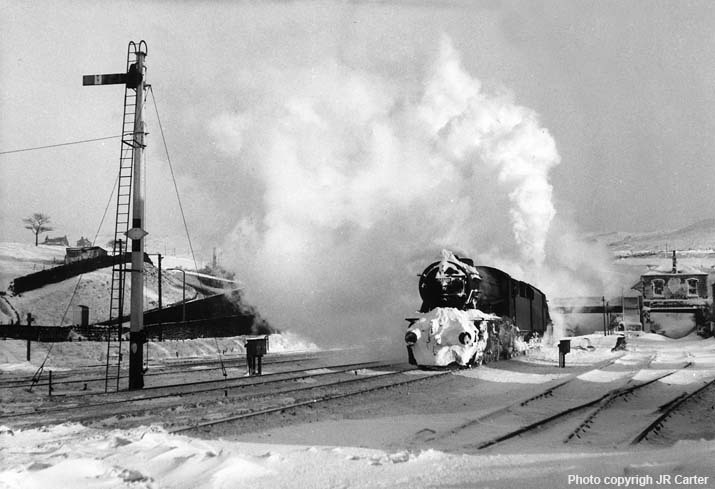
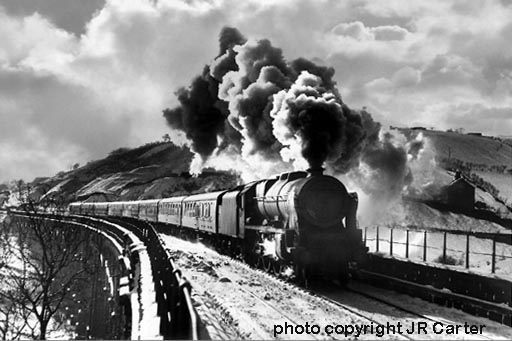
(Above-Below) 'Rebuilt Patriot' No 45545 Planet heads a Liverpool-Newcastle train across Dobcross Viaduct spanning the small River Tame and doubtless frozen Huddersfield & Ashton Canal in January 1963. (Below) The Huddersfield Narrow Canal is a waterway of startling contrasts, from tranquil countryside to dramatic moorland scenery and dark satonic mills. Here we have contrasting views of the viaduct from the canal tow path running alongside the Brownhills Visitors Centre at DobcrossThe canal tunnel is the oldest of the tunnels (built 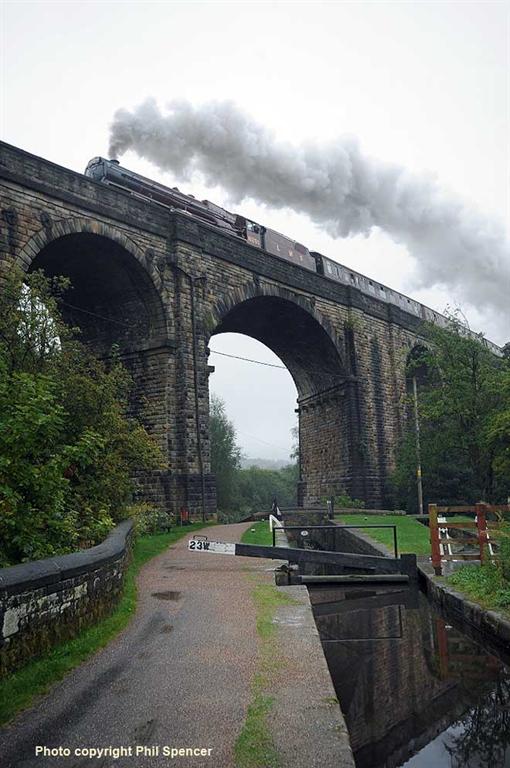

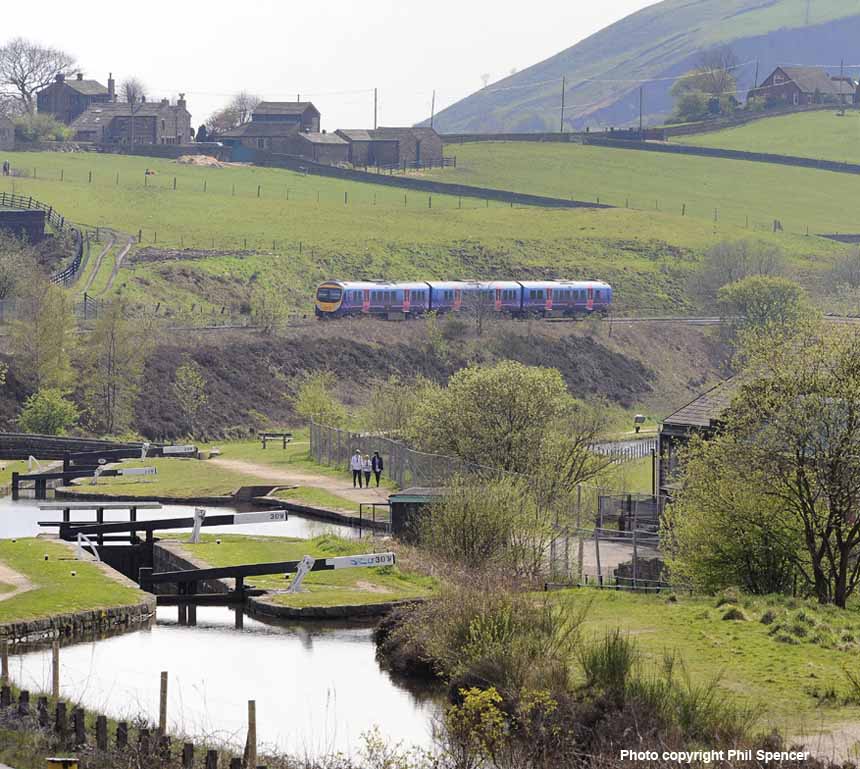
(Above-Below) The Huddersfield Narrow Canal runs for 20 miles between Huddersfield in West Yorkshire and Ashton under Lyne in Greater Manchester, and has a total of 74 locks. This is a view of Diggle Lock Flight looking towards Manchester. (Below) During the transition from steam to diesel traction on BR, the Swindon-built Trans-Pennine (TOPS Class 124) InterCity units were a stylish addition to the BR fleet. The service began on January 2nd 1961 between Hull and Liverpool, with 6 trains each way daily via the Standedge route. Their power/weight ratio made possible substantial acceleration of the Trans-Pennine service, though this Hull-bound set will struggle to keep to time having been held at signals due to snow clearing operations during the artic winter in January 1963. Photos © Phil Spencer and JR Carter.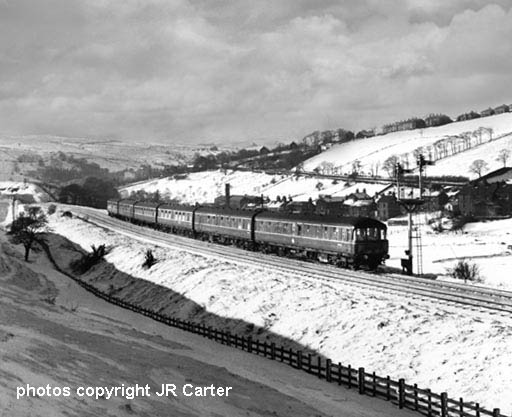

(Above) First TransPennine Express (FTPE) is responsible for operating inter-city train services on three main routes across the North of England. The Standedge route between Manchester and Leeds accommodates four express trains per hour between the two cities. This is made up of an hourly Liverpool Lime Street-Scarborough service, an hourly Manchester Airport-Newcastle service, an hourly Manchester Airport-Middlesbrough service and an hourly Manchester Piccadilly-Hull service. The TransPennine franchise is operated with Class 185 and Class 170 diesel multiple units. The Class 185 units, constructed in Germany by Siemens, entered service in March 2006 and are based at Ardwick Depot in Manchester. Smaller depots at York and Cleethorpes provide facilities for the stabling and light maintenance of the fleet east of the Pennines.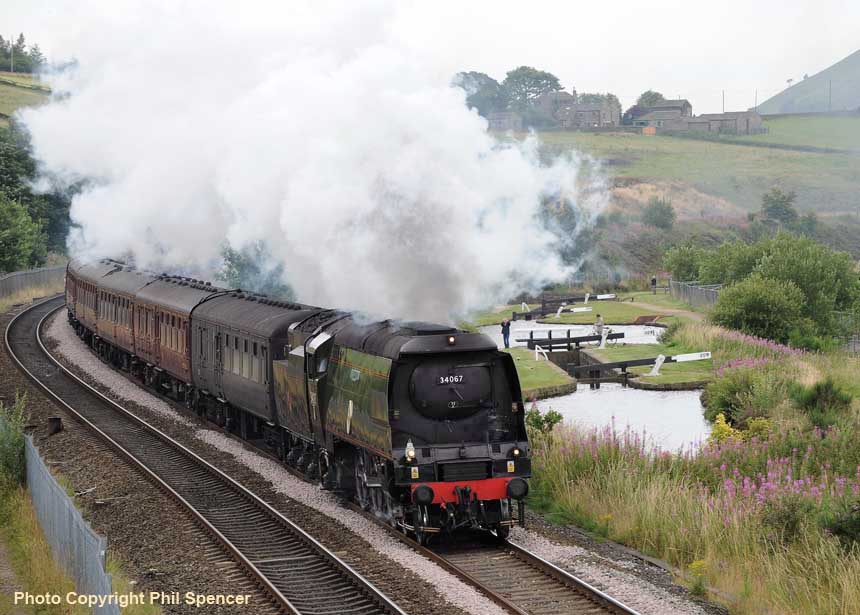

(Above-Below) The extent of rationalization of track at Diggle can be clearly seen in these striking 'Before-After' shots taken from above the single-bore portals of Standedge Tunnel looking towards Manchester.  Today the site of Diggle station (closed on 5th October 1968) is a rather remote spot with little sign of the extensive trackwork that once served this important Trans-Pennine rail route. In its heyday, the station had platforms serving all four lines but with the reduction of freight traffic and the elimination of many local train services in the 1960s, the 4-track section between Huddersfield and Stalybridge was reduced to two and this permitted the closure of the two single-bore railway tunnels at Standedge. Now that nature has taken its course little trace remains of any railway infrastructure, though Diggle Junction box - just visible in the background - remains as a block post and controls the goods loop on the down (Leeds) side.
Today the site of Diggle station (closed on 5th October 1968) is a rather remote spot with little sign of the extensive trackwork that once served this important Trans-Pennine rail route. In its heyday, the station had platforms serving all four lines but with the reduction of freight traffic and the elimination of many local train services in the 1960s, the 4-track section between Huddersfield and Stalybridge was reduced to two and this permitted the closure of the two single-bore railway tunnels at Standedge. Now that nature has taken its course little trace remains of any railway infrastructure, though Diggle Junction box - just visible in the background - remains as a block post and controls the goods loop on the down (Leeds) side.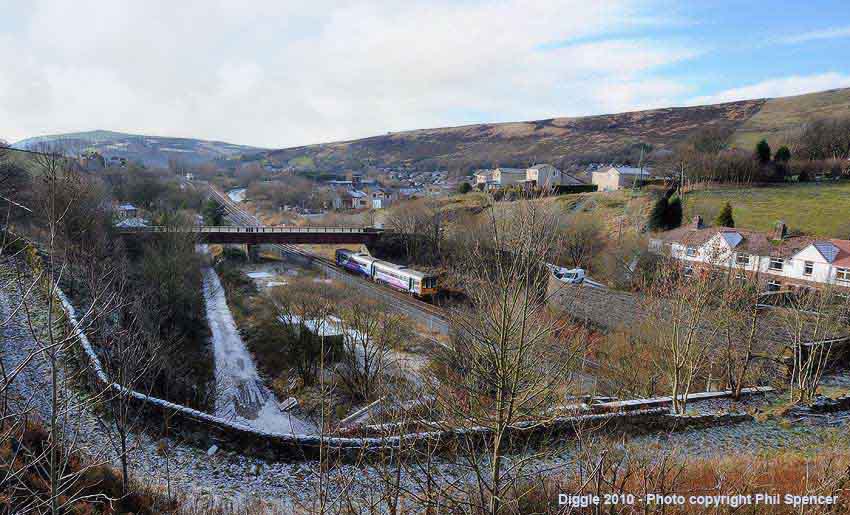
(Below) The 1960s saw something of a revolution on the Standedge route with the introduction of diesel-hauled services at hourly intervals between Leeds, Manchester and Liverpool. This included four through workings from Newcastle, hauled by EE Co Class 40 locomotives or one of Gateshead's Class 46 'Peaks'. At the same time, a new fleet of purpose-built 6-car express diesel multiple units began service on the route starting from Hull, while Metro-Cam dmus operated local services at 2-hourly intervals between Huddersfield and Manchester. During the 'Big Freeze' of 1963, fellow rail cameraman, Jim Carter, took this evocative shot of a Liverpool-Newcastle express headed by 'Peak' class No D157 (later Class 46 No 46038) eclipsing a Hull-Liverpool Trans-Pennine set at Diggle Junction. In the left background is Butterhouse Tunnel on the Micklehurst loop.

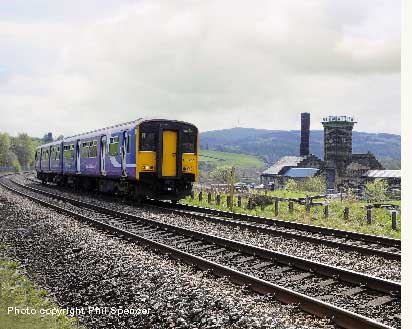 (Above) Fast-forward forty-odd years and the railway has changed considerably with closure of the Micklehurst loop and reduction of trackwork from four to two. When the First TransPennine Express franchise began operating a fleet of new Class 185 and Class 170 diesel multiple units on the route, I asked Phil if he could possibly get an up-to-date photo of the same spot, particularly as I was curious about the 'oversized' chimney pot (right background) in Jim's photo. In April 2009 Phil duly obliged with this shot of a 2-car Class 170 heading towards Manchester. At the same time, he put me right about the so-called chimney pot. It's an optical illusion, created by a factory chimney standing behind a water tower inside the Shaw Company's premises - see inset.
(Above) Fast-forward forty-odd years and the railway has changed considerably with closure of the Micklehurst loop and reduction of trackwork from four to two. When the First TransPennine Express franchise began operating a fleet of new Class 185 and Class 170 diesel multiple units on the route, I asked Phil if he could possibly get an up-to-date photo of the same spot, particularly as I was curious about the 'oversized' chimney pot (right background) in Jim's photo. In April 2009 Phil duly obliged with this shot of a 2-car Class 170 heading towards Manchester. At the same time, he put me right about the so-called chimney pot. It's an optical illusion, created by a factory chimney standing behind a water tower inside the Shaw Company's premises - see inset.
(Above-Below) Westbound Trans-Pennine units at Diggle. On the right is the Huddersfield Narrow Canal, which runs for 20 miles between Huddersfield and Ashton-under-Lyne. Work began in 1794, though long delays were encountered in the construction of a tunnel through Standedge Moor between Diggle and Marsden. Upon completion in 1811, it became the longest canal tunnel in Britain (3 miles 133 yards) and the highest above sea level at 645 feet, but due to its narrow 9ft bore (devoid of a tow path) horses were prevented from entering, therefore the animals were detached and taken across Standedge Moor to Marsden on the Yorkshire side while the boats were propelled through the tunnel by 'leggers'. This was the nickname given to the men (lying on the deck) who manhandled the boats by means of walking on the roof and tunnel sides. Over the years the canal fell into gradual decline and closed in 1944, however in 1974 the enterprising Huddersfield Canal Society was formed with the praiseworthy aim of re-opening of the tunnel. It was an enormous undertaking, but the Society's grand scheme for the canal's restoration was supported by Kirklees, Oldham and Tameside Councils and by British Waterways. The Standedge Tunnel was reopened in May 2001. For the record, the narrowboats using the canal today are towed through the tunnel in convoy by British Waterways' electric-powered tugs.
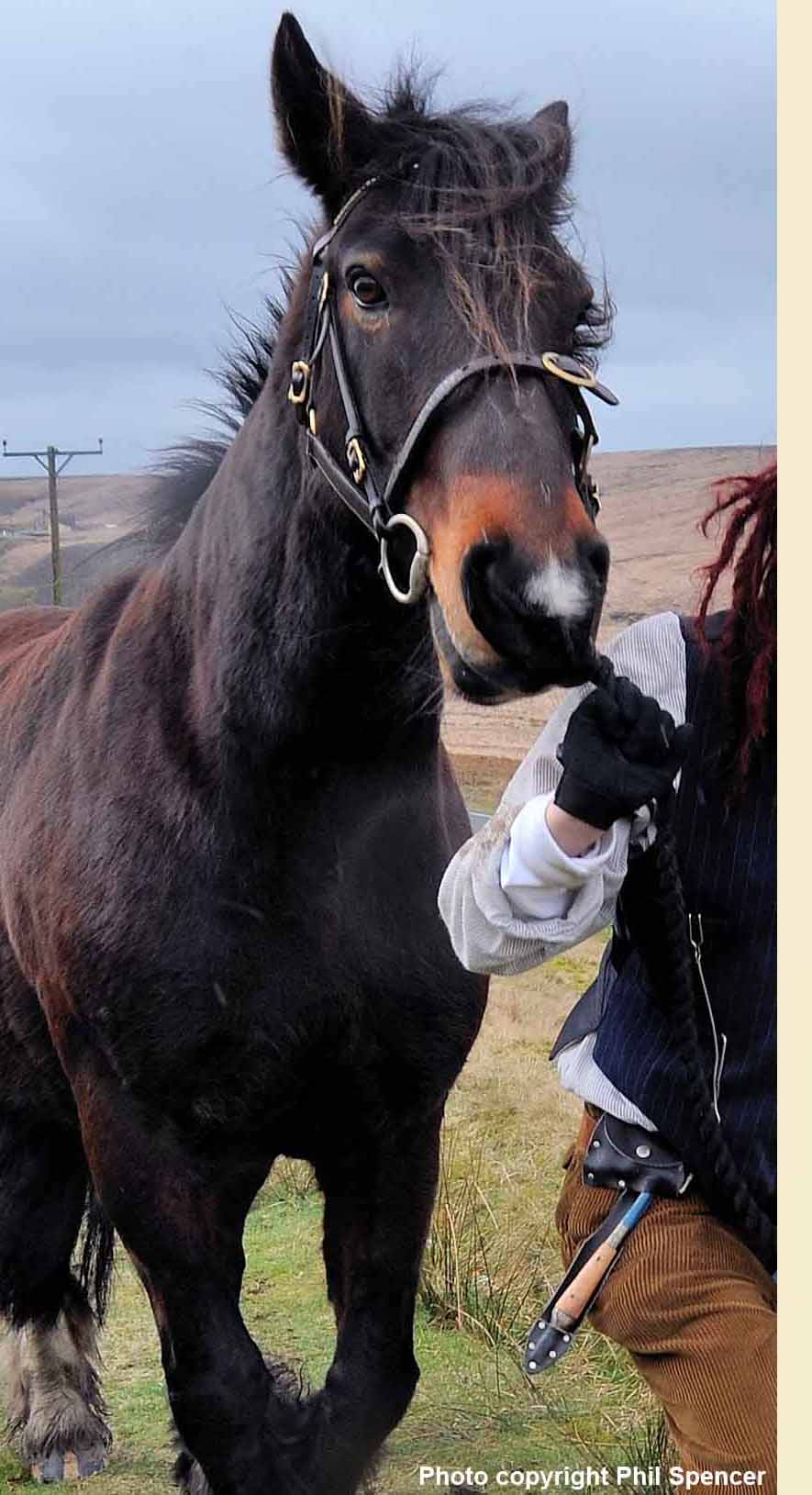 to Marsden. You don't have to go too far out of your way to discover why Britain's inland waterways have become popular places for leisure activities; an unhurried stroll along a canal tow path not only provides a welcome respite from our hectic lifestyles it gives us a glimpse of our long forgotten industrial heritage; many tow paths now have narrow gaps created by safety railings, barriers and gates to allow for public access, all of which makes good sense, particularly where children are concerned, but narrowing the width of a tow path does not take horse passage into consideration. This problem is exacerbated by the resurfacing of tow paths beneath the arches of bridges to allow for safer access to walkers, joggers, cyclists and families with prams, but lowering the height of some bridges forces a horse to walk very close to the water's edge, hence the handler's carry axes (seen here attached to Sharon's belt) which can be used to sever the tow rope in the event of a horse falling into the canal...click on photo once, then a second time to enlarge the photo. As part of the 200th anniversary celebrations in April 2011, the Horseboating Society took part in the landmark opening day. The Horseboating Society exists to promote horseboating and to preserve the heritage and skills of this once common form of transport. Journeys are carried out over the national network but especially in the north-west. Click here to visit the Horseboating Society's excellent web site.
to Marsden. You don't have to go too far out of your way to discover why Britain's inland waterways have become popular places for leisure activities; an unhurried stroll along a canal tow path not only provides a welcome respite from our hectic lifestyles it gives us a glimpse of our long forgotten industrial heritage; many tow paths now have narrow gaps created by safety railings, barriers and gates to allow for public access, all of which makes good sense, particularly where children are concerned, but narrowing the width of a tow path does not take horse passage into consideration. This problem is exacerbated by the resurfacing of tow paths beneath the arches of bridges to allow for safer access to walkers, joggers, cyclists and families with prams, but lowering the height of some bridges forces a horse to walk very close to the water's edge, hence the handler's carry axes (seen here attached to Sharon's belt) which can be used to sever the tow rope in the event of a horse falling into the canal...click on photo once, then a second time to enlarge the photo. As part of the 200th anniversary celebrations in April 2011, the Horseboating Society took part in the landmark opening day. The Horseboating Society exists to promote horseboating and to preserve the heritage and skills of this once common form of transport. Journeys are carried out over the national network but especially in the north-west. Click here to visit the Horseboating Society's excellent web site.
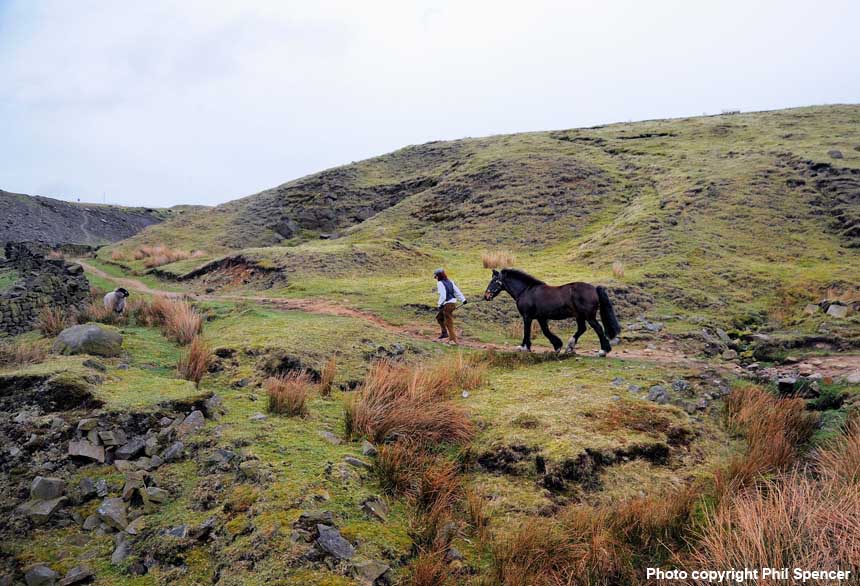


(Above-Below) The advent of the railways saw the demise of the Huddersfield Narrow Canal, which fell into slow decline and was eventually closed in 1944. Here Class 45 'Peak' No 45111 Grenadier Guardsman emerges from Standedge Tunnel with the 12.05 Liverpool-Scarborough in May 1983. (Below) On the same day an unidentified Class 47 heads a Liverpool-Newcastle train. On the right is the Huddersfield Narrow Canal, less than 7ft wide, which enters the hillside through a 5,456 yard long bore at a lower level beneath the railway. The bridge carries overspill water from a local reservoir.

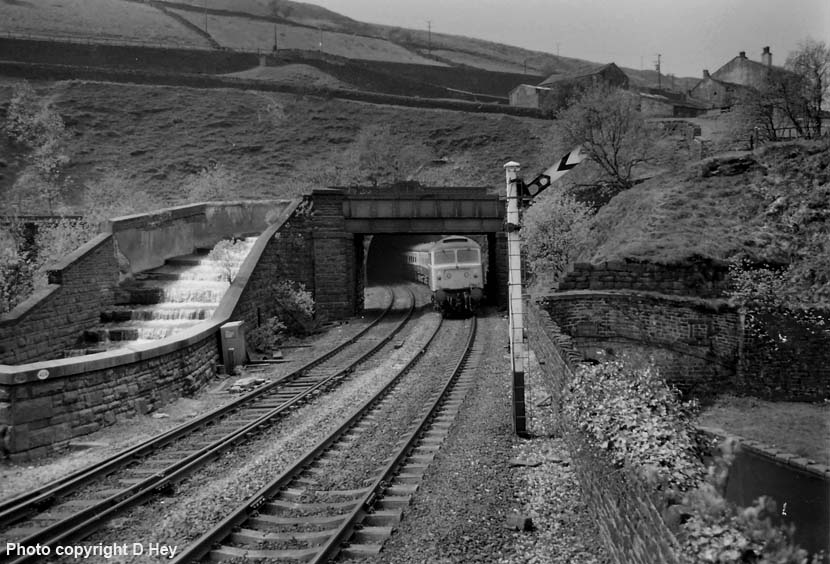
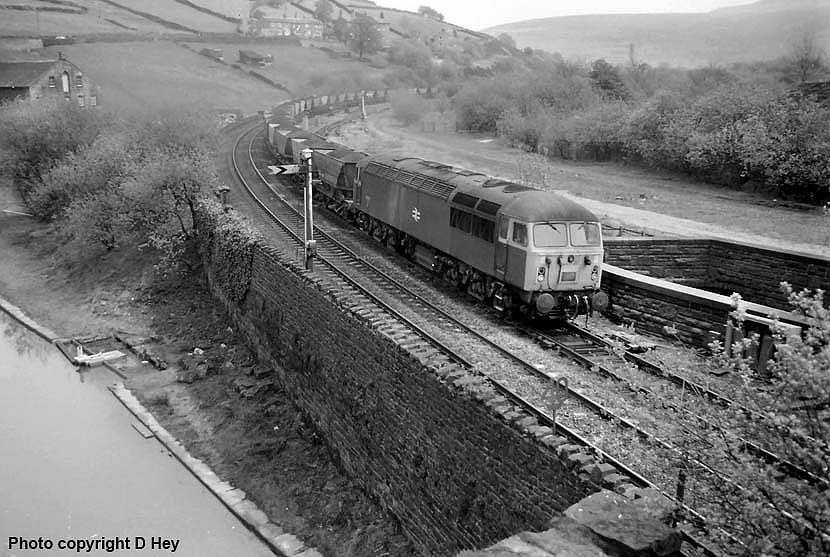
(Above-Below) An unidentified Class 56 approached Standedge Tunnel with a heavy MGR train from the Yorkshire coalfied to Fiddlers Ferry Power Station. (Below) In the opposite direction, a 'Peak' heads a Liverpool-Newcastle Trans-Pennine express downhill to Huddesfield.
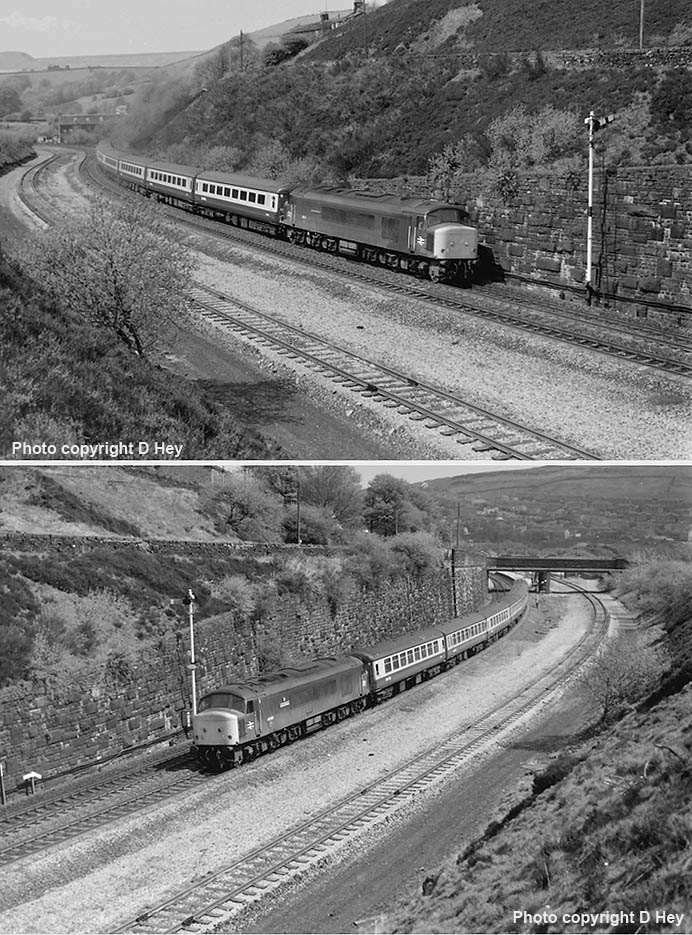
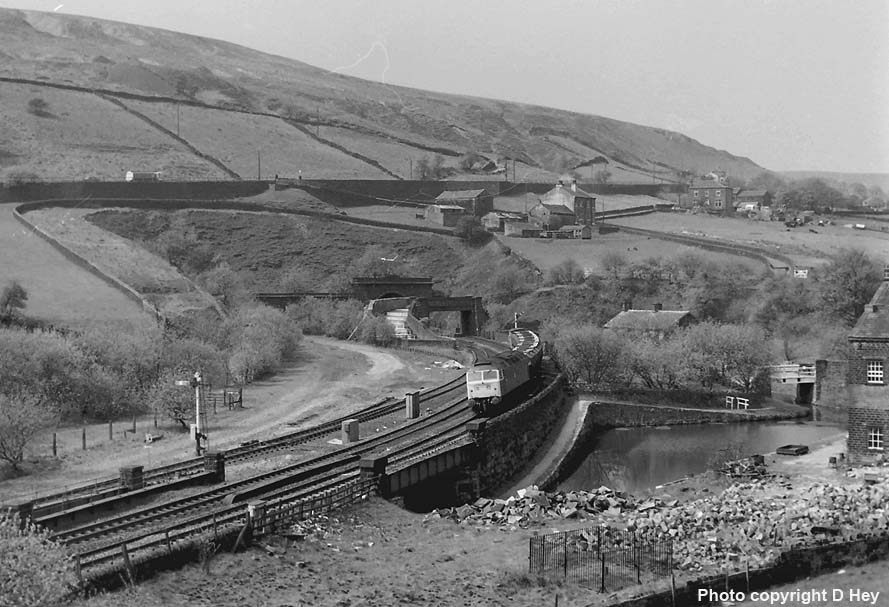

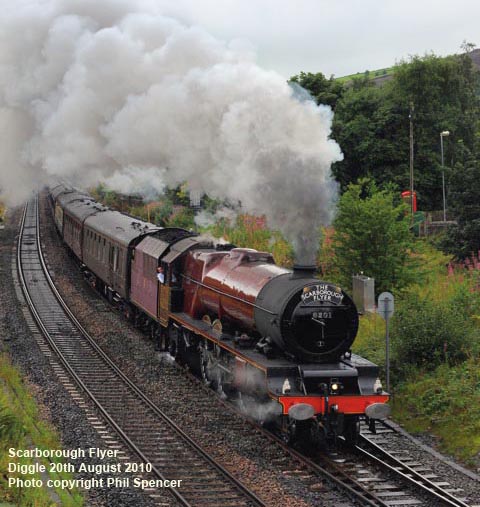
(Above) On 23rd July 2010, the Railway Touring Company's 'Scarborough Flyer' began running from Crewe, Wilmslow and Stockport to York and Scarborough. The service was scheduled to run every Friday until 10th September, leaving Crewe at 07:30am, Wilmslow at 08:00am, Stockport at 08:20am, and on the return, arriving at Stockport at 20:55, Wilmslow at 21:05 and Crewe at 21:35. Here, Stanier Pacific No 6201 Princess Elizabeth gets to grips with wet rails on the climb to Standedge Tunnel on 20th August 2010. Today the importance of Diggle as a railway centre is scarcely apparent. After the station closed in October 1968, much of the track layout passed into history and the abandoned trackbed is gradually vanishing in the undergrowth, however one item of past-present identification is common in both photos - the old-red telephone box which seems to have stood the test of time very well!
(Below) Phil captures the scene at Marsden looking down from above the tunnel, as 6201 Princess Elizabeth heads the return leg of the Railway Touring Co's 'Scarborough Flyer' on 20th August 2010. Phil adds: What a wet, miserable night! Several photographers called it a day. The light faded so fast that I ended up taking this shot in virtual darkness at 8.35pm on a Nikon D3 using a 70-200mm Nikkor lens at 3200 iso - the exposure was 1/125 sec at f5. The train had been put into the Marsden Loop for some 25 minutes before getting up steam for the climb through Standedge Tunnel to Diggle.

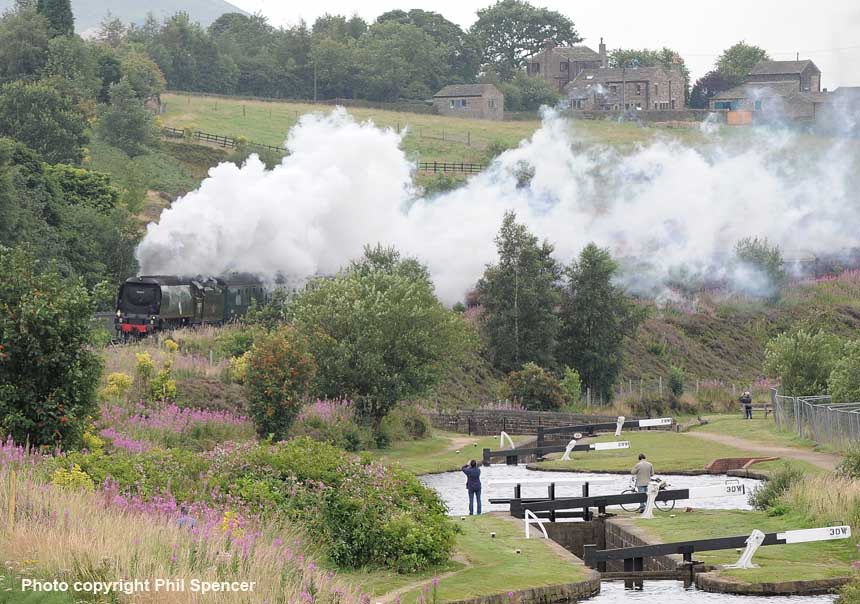
Polite notice: All text and photographs are protected by copyright and reproduction is prohibited without the prior consent of the © owners. If you wish to discuss using the contents of this page the email address is below. Please note - this is not a 'clickable' mail-to link via Outlook Express. You will have to email manually.
dheycollection@ntlworld.com








